Roadside Best Management Practices that Benefit Pollinators
Handbook for Supporting Pollinators through Roadside Maintenance and Landscape Design
Printer-friendly PDF Version (4.9 MB)
Printer-friendly, high-resolution PDF Version (25.2 MB)
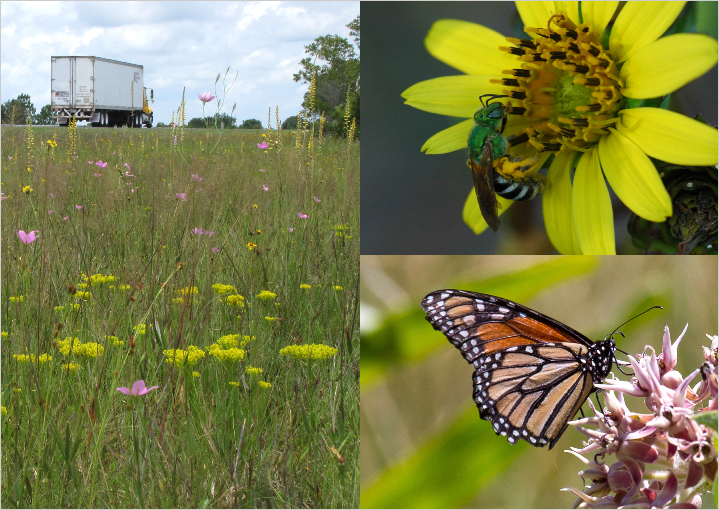
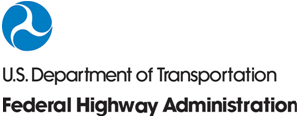
Photographs
Our thanks go to the agencies, organizations, and individuals for allowing us to use their photos. Ownership of all photos remains with the photographers.
Front Cover
Left: Native prairie roadside in Florida; courtesy Jeff Norcini.
Right upper: Metallic sweat bee on sunflower; courtesy the Xerces Society.
Right lower: Monarch butterfly on showy milkweed; courtesy USFWS Midwest.
Technical Report Documentation Page
1. Report No.
FHWA-HEP-16-059
|
2. Government Accession No.
|
3. Recipient's Catalog No.
|
|
4. Title and Subtitle
Roadside Best Management Practices that Benefit Pollinators: Handbook for Supporting Pollinators through Roadside Maintenance and Landscape Design
|
5. Report Date
December 2015
|
|
6. Performing Organization Code
|
|
7. Author(s)
Jennifer Hopwood, Scott Black, and Scott Fleury
|
8. Performing Organization Report No.
|
|
9. Performing Organization Name and Address
ICF International
ICF Incorporated, L.L.C.
9300 Lee Highway
Fairfax, VA 22031
Xerces Society for Invertebrate Conservation
628 NE Broadway, Suite 200
Portland, OR 97232
|
10. Work Unit No. (TRAIS)
|
|
11. Contract or Grant No.
DTFH61-11-00033/TO 5001
|
|
12. Sponsoring Agency Name and Address
Federal Highway Administration
1200 New Jersey Ave SE
Washington, DC 20590
|
13. Type of Report and Period Covered
Best Management Practices
2015
|
|
14. Sponsoring Agency Code
HEPE-1
|
|
15. Supplementary Notes
Contracting Officer's Representative: Deirdre Remley, FHWA, HEPE-20, 202-366-0524
|
|
16. Abstract
Pollinators are critical to our food supply as well as to the health of ecosystems. Wild pollinators such as the monarch butterfly and a number of bumble bee species are in decline, and beekeepers in the United States and Europe have reported significant losses of managed European honey bee colonies. Pollinator declines are attributed to loss of habitat, pesticide exposure, diseases, parasites, and effects of introduced species. Roadsides can benefit pollinators by providing foraging habitat, places to breed, nest, and overwinter, and may act as corridors, linking patches of fragmented habitat.
These best management practices identify key steps that State Departments of Transportation (DOTs) can take to improve the quality of roadside habitat for pollinators including 1) adjusting roadside vegetation management techniques to accommodate pollinator resource needs, 2) enhancing and restoring native roadside vegetation to include plant materials that improve pollinator habitat, and 3) incorporating native plants and pollinator habitat needs into roadside landscape design.
|
|
17. Key Words
pollinators, integrated roadside vegetation management, butterflies, bees, moths, nectar plants, host plants, roadside habitat, reduced mowing, native plants, roadside landscape design, roadside maintenance
|
18. Distribution Statement
No restriction. This document is available to the
public from the sponsoring agency at the website https://www.environment.fhwa.dot.gov/ecosystems/vegmgmt_pollinators.asp.
|
|
19. Security Classif. (of this report)
Unclassified
|
20. Security Classif. (of this page)
Unclassified
|
21. No. of Pages
88
|
22. Price
$0.00
|
For additional information, please contact Anne Rowe (Anne.Rowe@dot.gov).
Contents
Introduction
Pollinators and Roadsides: Background Information
Meet the pollinators
We need pollinators
Pollinators need roadside habitats
You can manage roadsides to help pollinators
Questions you may have about pollinators and roadsides
Best Management Practices for Roadside Maintenance and Design
BMP 1 Protecting and Managing Remnant Habitat and Existing Stands of Native Vegetation
Case Study: Special Management Areas in Oregon
BMP 2 Adjusting Mowing Practices to Benefit Pollinators
Case Study: Pilot Project in Florida Reveals Energy and Cost Savings
BMP 3 Reducing the Impacts of Herbicides on Pollinators
Case Study: Reducing Herbicide Use on Oregon's Roadsides
BMP 4 Employing Multiple Vegetation Management Strategies
BMP 5 Designing Your Roadside Landscapes to Benefit Pollinators
Text Box: Why Use Native Plants?
Case Study: Caltrans' Ecoregional Seed Mixes
BMP 6 Adopting Proven Native Plant Establishment Methods
Case Study: Establishing Native Plants in Arizona
Case Study: Iowa’s Natural Selections Program increases Iowa Native Seed
Text Box: Reducing Costs and Finding Funding to Support the Use of Native Plant Materials
BMP 7 Raising Public Awareness
Case Study: Ohio DOT’s Bee Pollinator Habitat Program
BMP 8 Training Your Staff
Text Box: Sample Workshop Outline: Roadside Vegetation Management for Pollinator Conservation
Text Box: Sample Workshop Outline: Roadside Landscape Design for Pollinator Conservation
Final Summary: Roadsides and Pollinators can go Hand in Hand
Appendix A: Pollinator and Vegetation Resources
Appendix B: Lists of Pollinator-Friendly Plants
Introduction
Pollinators are essential to our well-being and are at the heart of healthy ecosystems. However, pollinators are in trouble. Wild pollinators such as monarch butterflies and many bumble bee species, as well as colonies of managed honey bees, are experiencing declines due to a loss of habitat, the spread of disease, overuse of pesticides, and various other factors. Declines of pollinators threaten the viability of our agricultural productivity and put the health of natural ecosystems at risk.
Roadside vegetation can provide much needed habitat for pollinators, providing food, shelter, and connections to other patches of habitat. Roadside managers, maintenance staff, and landscape designers can all take steps to improve the quality of roadside vegetation to benefit pollinators, steps that can also reduce costs, maintain public safety, and improve public good will. Roadsides play an important role in the conservation of declining wild pollinators and in supporting the health of managed pollinators.
In 2015, the United States White House released the National Strategy to Promote the Health of Honey Bees and Other Pollinators. The strategy outlines ways to address the decline of pollinators, including a specific directive to improve habitat on roadside rights-of-way.
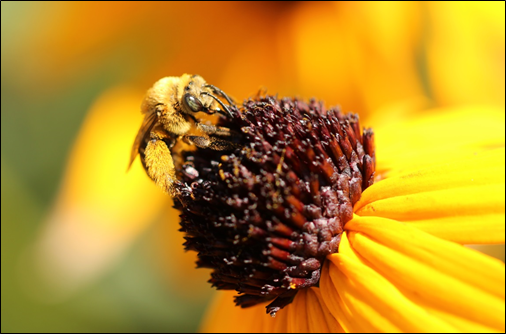
(Photograph courtesy the Xerces Society.)
This document provides you with practical information on how to plan and implement changes in roadside vegetation management that will benefit pollinators. The document includes:
- Background information about the importance of pollinators for people and ecosystems, the importance of roadsides for pollinators, and an overview of how roadside management can support pollinator conservation.
- Best management practices (BMPs) for maintaining and designing roadside vegetation. These include information on:
- Reducing the potential negative impacts of some vegetation management techniques on pollinator habitat,
- Modifying practices to substantially increase the quality of roadside vegetation for the benefit of pollinators, and
- How landscape designers can increase the value of new roadside plantings for pollinators.
This document is based on the latest science as summarized in a literature review of peer-reviewed and technical material (see Appendix A) and the practical experience of roadside vegetation management practitioners, as described through interviews with state departments of transportation (DOTs) and roadside restoration experts. This document is a companion to Pollinators and Roadsides: Best Management Practices for Decision Makers, a publication that synthesizes pollinator conservation science and outlines roadside management practices that can benefit pollinators.
Transportation professionals can make a significant contribution to pollinator conservation and will help sustain the economic and ecological services pollinators provide by managing roadsides to benefit pollinators. The Federal Highway Administration (FHWA) provides this information for transportation agencies to consider adopting and integrating the practices described here into their roadside maintenance and design operations.
Back to top
Pollinators and Roadsides: Background Information
Meet the pollinators
Pollination is a mutually beneficial interaction between plants and pollinators. Animals visit flowers seeking food in the form of sugary nectar and/or protein-packed pollen grains, and in the process of foraging transfer pollen grains between blooms, enabling flowering plants to reproduce. The great majority of pollinators are insects, including bees, wasps, flies, beetles, butterflies, and moths, but hummingbirds and nectar-feeding bat species pollinate as well. Bees are particularly efficient (and important) pollinators. Colonies of honey bees (Apis mellifera), a domesticated species introduced from Europe, are managed by beekeepers to provide crop pollination services as well as honey production. North America’s native bees have very different lifestyles than honey bees and most are wild and unmanaged. However, many of these wild bees are also important crop pollinators. For more information about the biology of pollinators, see the resources in Appendix A.
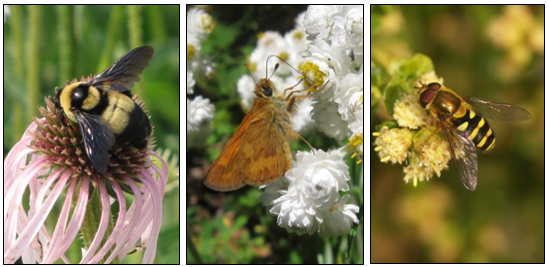
Pollinators are a highly diverse group of animals. The majority are insects, including (from
left to right) bumble bees, butterflies, and flower flies. (Photographs courtesy the Xerces Society.)
Back to top
We need pollinators
The ecosystem services provided by pollinators are essential to human well-being, agricultural production, and ecosystem health. An estimated 85% of the world’s flowering plants depend on animals—mostly insects—for pollination. Pollinators sustain wildland plant communities that provide food and shelter for myriad other wildlife. In short, pollinators are an indispensable component of a healthy environment.
Pollinators are also crucial to agriculture and to our diet. More than two-thirds of crop species are dependent upon pollinators, including crops that produce fruits, vegetables, spices, nuts, seeds, and livestock forage. From the coffee you drink in the morning to the apple pie you have for dessert, an estimated one-in-three mouthfuls of food and drink that you consume come from a pollinator-dependent crop. In fact, the majority of minerals, vitamins, and nutrients we need to maintain our health (such as vitamin C, calcium, and folic acid) come from fruits and vegetables that depend partially or fully on animal pollinators. The value of insect crop pollination is estimated to be up to $27 billion in the United States.
Pollinators need roadside habitats

When thoughtfully designed and managed, roadsides can provide both high-quality habitat for a wealth of pollinators and beautiful landscapes for traveler, as illustrated by this road through Gonzales Pass, Arizona. That state's Department of Transportation has used only native plants in roadside projects for more than two decades. (Photograph courtesy Arizona DOT.)
Pollinators are in decline. The number of honey bee colonies in the U.S. has been falling over the past half-century, and since 2006, beekeepers have experienced record high annual average hive losses of 29% or more. Honey bee colony losses are attributed to disease, parasites, lack of habitat that provides sources of nectar and pollen, pesticides, and other factors.
Numerous wild, unmanaged pollinator species native to North America also appear to be experiencing similar or more severe declines than honey bees. For example, at least 25% of North America’s bumble bee species have undergone significant and swift declines, including species like the rusty-patched bumble bee (Bombus affinis) that were formerly common and widespread. Habitat loss, insecticide exposure, and disease are all contributing factors. Similarly, butterflies have also undergone significant declines: 17% are at risk of extinction, including species with special habitat needs as well as generalist species that were once widespread. For example, the monarch (Danaus plexippus), an iconic butterfly that is found across North America, has experienced population declines of 80% east of the Rocky Mountains and of 50% to the west. Loss of breeding habitat—habitat that includes the monarch’s milkweed host plants—is a significant factor contributing to this decline. Similarly, some hummingbirds across the U.S. and nectar-feeding bats throughout the southwestern United States have also experienced declines due to loss of habitat.
Declines of pollinators have focused attention on efforts to help bees and butterflies through habitat restoration and habitat management. Roadsides form an extensive network of linear habitat across all types of land. With an estimated 17 million acres of roadsides managed by state DOTs in the U.S., managing roadsides is a significant conservation opportunity for pollinators that are greatly in need of quality habitat in order to survive.
Back to top
You can manage roadsides to help pollinators
Roadsides are typically dominated by early successional plant communities and can offer feeding, breeding, or nesting opportunities for pollinators, and also aid dispersal of pollinators by linking fragmented habitats. With the right conditions, roadsides can support a diversity of generalist pollinators, including bumble bees, honey bees, butterflies, and hummingbirds as well as rare or federally listed species. Roadsides extend through all landscapes and can be particularly important sources of habitat for pollinators in highly altered landscapes such as intensely managed agricultural lands.

A Texas roadside awash with bluebonnet (Lupinus texensis), the official state flower. Native plants can be used as a way to boost local pride as well as create pollinator habitat and enhance a driver's experience. (Photograph courtesy Texas DOT.)
Not all roadsides are equally beneficial to pollinators. Roadsides that are intensively mown, blanket-sprayed with herbicides, or planted with introduced grasses support far fewer species of pollinators and smaller population densities than roadsides managed for native plants. Roadside vegetation management influences how pollinators use roadsides, and even influences the number of pollinators killed by vehicles driving nearby. Researchers in Europe found that the frequency of mowing was linked to the proportion of butterflies killed on roads because they were forced to disperse to find new habitat after roadsides were mowed. In contrast, mortality was lower where roadsides had more species of plants and higher quality of habitat because butterflies did not have to fly to new areas. By reducing the need for pollinators to disperse elsewhere to find food or nesting sites, high-quality roadside habitat may reduce the numbers of pollinators killed by vehicles.
There are two fundamental approaches to improving the quality of roadside habitat for pollinators:
- adjusting vegetation management strategies to accommodate pollinator resource needs and
- enhancing and restoring native vegetation along roadsides.
This publication offers detailed information to help roadside managers, maintenance crews, and landscape designers manage roadside vegetation to benefit pollinators.
Back to top
Questions you may have about pollinators and roadsides
The general public and managers alike may be surprised to learn that roadsides are important sources of habitat for pollinators. The answers to the frequently asked questions that follow may help you respond to any inquiries, either internal or from the public, about why your transportation agency is adapting roadside management practices to benefit pollinators.
How are roadsides useful to pollinators?
Roadsides offer several ecological benefits for pollinators. The vegetation can provide food for pollinators, such as wildflowers that bees rely on as sources of pollen and nectar, and the caterpillar host plants that butterflies and moths need to complete their life cycle. They provide breeding or nesting opportunities for pollinators, as well as shelter and overwintering habitat. Roadsides also help pollinators to move through landscapes by linking fragmented habitats—and the roadsides themselves give refuge to pollinators in otherwise inhospitable landscapes.
What types of roadside management strategies benefit pollinators?
Roadsides with abundant wildflowers, especially native plants, managed by judicious mowing, herbicides, and other management tools, provide the best pollinator habitat. Shrubs and trees are also important components of pollinator habitat, when compatible with the design of the roadside. (For detailed information, please see the BMPs that follow.)
Are collisions with vehicles a major source of mortality for pollinators?
Hundreds of thousands of pollinators are killed by vehicles on roads, but research suggests that the numbers appear to be a small proportion of overall populations. Road mortality can be higher for some species of pollinators than others. For example, butterflies appear to be one of the more common groups of insects killed by cars, although studies show that mortality rates range from 0.6% to a maximum of 10% of the population, depending on the species. Some butterflies that are strong fliers have the ability to dodge vehicles, while other less adroit species are more susceptible. Although pollinators and other wildlife are going to be killed by vehicles as long as we have roads, by improving roadside habitat for pollinators through vegetation management, we can actually reduce pollinator road mortality.
If the amount of wildflowers on roadsides increases, will the number of pollinators killed on roads increase too?
Many people are concerned that by increasing the quality of habitat on roadsides, more pollinators will be killed by vehicles. In fact, research indicates that, rather than luring pollinators to their death by vehicle, roadsides with high quality habitat actually reduce pollinator mortality because the insects stay on the roadside instead of leaving to search for flowers. Reducing roadside mowing can reduce butterfly mortality, as can enhancing the diversity and abundance of wildflowers on roadsides.
If roadsides are mown less frequently, will this impact driver safety, especially collisions with deer?
Current research indicates that the frequency of mowing of the entire roadside doesn’t appear to influence rates of deer-vehicle collisions. Deer may actually prefer some roadsides that are mowed more frequently because mowing can increase the palatability of some plants. Regular mowing of a strip of vegetation adjacent to the pavement to maintain the clear zone, while letting the rest of the roadside grow to a reasonable height, can help to maintain visibility for drivers and prevent deer–vehicle crashes.
Are there other advantages to reducing mowing and herbicide use beyond helping pollinators?
Often there are cost savings associated with reduced mowing and efficient herbicide use. There are also many ecological benefits, including reduced carbon emissions, reduced herbicide runoff, and improved habitat for small wildlife such as grassland birds.
Do pollinators need native plants on roadsides?
Native plants support more species and a greater abundance of pollinators than do nonnative plants. Some pollinators will use nonnative plants as sources of food or as shelter, but most pollinators prefer native plants. Roadsides with native plants are the most valuable to pollinators.
Why use native plants in new roadside plantings if they are more expensive than nonnative species?
In addition to their value to pollinators, there are many advantages of using native plants to stabilize roadsides. Native grasses and flowers are best adapted to local growing conditions, require minimal inputs for establishment, and are able to tolerate extreme weather events such as drought. The root systems of native plants can increase water infiltration, which reduces runoff and water pollution and keeps our waters cleaner. A diverse native plant community can reduce soil erosion and resist weed invasions, which can reduce maintenance costs. Although native plants may cost more upfront, they can provide cost savings over time. Native plants can be aesthetically pleasing during the growing season while also acting as snow fences in the winter, trapping and preventing snow from blowing across roads. Native plant communities also support more birds, pollinators, and other wildlife. The use of native plants in roadsides can provide ecological benefits to the surrounding landscape.
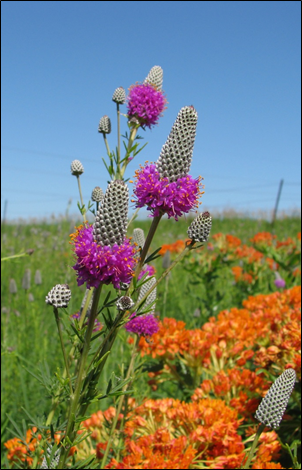
Purple prairie clover (Dalea purpurea) and butterfly milkweed (Asclepias tuberosa) combine to create a striking roadside display—and provide habitat. (Photograph courtesy Iowa Living Roadway Trust Fund.)
Will any of the wildflowers planted on roadsides spread to adjacent property and become weeds?
Native plants in roadsides, especially locally sourced plants, are less likely than many nonnative plants to create weed issues and encroach onto adjacent land.
Are milkweeds present in the roadside a threat to livestock on adjacent land?
Milkweed species present in roadsides are unlikely to be a threat to livestock on adjacent property. Very few milkweeds will spread from their planting site. If milkweeds are present in pastures or rangelands, most livestock take great care to avoid them. Although milkweeds are toxic, livestock find them highly unpalatable. Milkweed poisoning typically only occurs when livestock are confined to a barren paddock with no alternate food sources. However, palatability of milkweed increases when it is dry. If adjacent landowners are haying the roadside, it is important to be cautious about feeding that hay to livestock, if milkweed density is high.
Should milkweeds be included in new roadside plantings?
Milkweeds are important to include in new roadside plantings because they are host plants for the monarch butterfly and a source of abundant nectar for this and many other species. Roadsides with milkweeds can become breeding habitat for monarchs, habitat that is crucial to the monarch butterfly’s recovery.
Can adjacent lands benefit from their proximity to roadside habitat?
Natural and semi-natural habitat on roadsides can contribute to the maintenance of healthy ecosystems and the provision of ecological services such as crop pollination. Roadside habitat increases the diversity and stability of the pollinator community. When near farms, this can improve pollination and increase crop yields. Roadside pollinator habitat will also support the beneficial insects that are predators of crop pests and that can contribute to natural pest control. In addition, roadside habitat can reduce soil loss and water runoff, and provide other ecological benefits that can translate to economic savings.
What are some interesting pollinator facts that I can share with the public or my agency?
The majority of our wild native bees live as solitary individuals, unlike honey bees, which live in large social colonies of thousands of bees. In contrast, a female solitary bee will construct her own nest and collect and provide food for her offspring by herself. Bumble bees and some sweat bees are the only native bees that form social colonies, which are much smaller than a honey bee hive, usually fewer than two hundred bees.
Due to their solitary nature, most native wild bees are gentle and are unlikely to sting unless grabbed. Only social bees such as honey bees and bumble bees are likely to sting in defense when their nest is disturbed.
Bees are often confused with wasps, especially social wasps such as yellowjackets, which more readily use their stinger because they are predators. These are typically the insects that disturb picnics or dinners on the back deck.
The value of pollinator-dependent crops in the U.S. was estimated to be between $18 and $27 billion in 2003. This value would likely double if the calculation was expanded to include indirect products of animal pollination, such as milk or meat from animals fed pollinator-dependent forage crops like alfalfa.
Back to top
Best Management Practices for Roadside Maintenance and Design
Roadside managers can play an important role in pollinator conservation by making adjustments to their management practices. Managing roadsides to preserve or enhance existing flowering plants provides valuable habitat for pollinators. Often these changes to management practices result in cost savings and improved aesthetics.
Landscape architects, roadside operations managers, engineers, and others that design and implement roadside plantings can also contribute to pollinator conservation. The functional requirements of roadside vegetation to provide a safe driving environment, minimize maintenance costs, maintain good public relations, reduce water runoff and soil erosion, and withstand weed invasions and disturbances can all be met while incorporating design elements that benefit pollinators.
The best management practices that follow will enable you to maintain roadside vegetation and design roadside plantings in ways that increase the number and diversity of pollinators, and support pollination services for nearby crops and native plant communities. They can be adapted to a particular region and situation, recognizing that transportation agencies have different resources and constraints.
BMP 1 - Protecting and Managing Remnant Habitat and Existing Stands of Native Vegetation
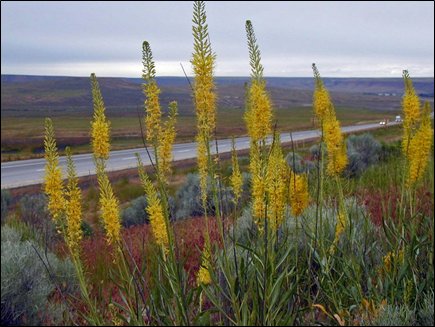
Protecting and maintaining existing native habitat should always be the first step in pollinator conservation. (Photograph courtesy Idaho DOT.)
Overview
Inventories of roadside vegetation to identify existing roadside habitat as well as weed problems, followed by site-appropriate management plans, will help to manage existing roadside vegetation effectively, while also benefiting pollinators.
Essentials
Transportation agencies can protect and manage existing natural roadside habitat for the benefit of pollinators by:
- conducting inventories of roadside vegetation and
- developing and implementing site-appropriate management plans that maintain plant diversity.
Identifying, protecting, and managing remnant habitat and other existing stands of native vegetation on roadsides can support the health of pollinators and ecosystems. Pollinators are more abundant and diverse on roadsides with native plants than roadsides with nonnative plants. Native plants provide pollen and nectar as food for pollinators, are host plants for butterflies and moths, and provide nesting material and shelter for pollinators. Roadsides with existing stands of native vegetation can serve as valuable habitat for pollinators.
As the last remaining patches of natural communities that were once present on a much larger scale, habitat remnants have high conservation value. In fact, in some regions, roadside habitat remnants are the only patches of these important natural resources. Remnants can support rare plants and a variety of wildlife, including pollinators such as bees, butterflies, and hummingbirds. Pollinators with very specialized habitat needs particularly benefit from the preservation of remnants. Additionally, managing existing stands of native vegetation effectively is cost effective and increases a state’s scenic beauty.
Conducting inventories of roadside vegetation
A roadside vegetation inventory involves the mapping of the composition and condition of the current roadside vegetation, including native, invasive, and noxious weeds. Roadside vegetation inventories can inform management plans that can benefit pollinators in a number of ways. Identification of remnant habitat can allow roadside managers to make informed decisions about how to manage such areas to maintain and improve the vegetation community, to help sensitive species to survive, and to provide for a suite of generalist pollinators and other wildlife. Roadside inventories can also be used to map out existing weed issues and identify emerging weed problems. Inventory data can then be used to help target management operations to reduce costs and to evaluate the effectiveness of weed management techniques. Finally, inventories can help inform and direct future plantings when used to identify rights-of-way that might be candidates for future revegetation efforts.
An inventory may be conducted by doing the following:
- Evaluating roadside conditions. It is important to focus on evaluating existing roadside vegetation conditions that are relevant to pollinators. Possible criteria to assess include the type of vegetation, remnant habitats, noxious and invasive weeds, adjacent land use, and width and topography of the right-of-way.
Efficient and effective inventories involve individuals with botanical expertise, such as individuals that are trained to identify weeds, distinguish native vegetation, and identify the sensitive plant species that can indicate intact remnant habitat. If your transportation agency does not have botanical expertise among staff, you can create partnerships with botanical experts from state agencies, conservation organizations, or universities to conduct or assist with roadside vegetation surveys.

Botanists with Oregon DOT mark rare plants during a survey of a Special Management Area beside Interstate 5. (Photograph courtesy Oregon DOT.)
Roadside vegetation can be categorized by type in your inventories, and this information will be useful when determining management activities and potential sites for future plantings of native vegetation. Because it is impractical to identify every species of plant along the roadside, plants that are similar can be grouped together by type. Potential categories include warm season grasses, cool season grasses, legumes, forbs, shrubs, and trees.
Identifying remnant plant communities can help transportation agencies determine the best management to maintain these areas. Remnants are often identified by plant species that are not present elsewhere in areas that have been plowed or heavily grazed.
Identifying invasive plants to species can help transportation agencies determine the best control strategies. You may wish to conduct inventories regularly to track invasive species over time to monitor the success of control methods.
Inventories can also include information such as adjacent land use, topography, and the width of the right-of-way. These factors can all influence vegetation management plans and future efforts to establish native vegetation.
- Collecting spatial data. It can be helpful to use GPS (global positioning system) technology in conjunction with the roadside vegetation conditions data. GPS data can be imported into a geographic information system (GIS), where data can be reviewed and maps created. These tools help to make inventory data easier to capture, analyze, and share within your transportation agency and with other partners.
- Performing inventories. Common methods to collect roadside inventory data include using driving surveys or by collecting video footage or photos. Targeted field surveys help to refine plant identifications, as appropriate.
Driving surveys involve one person surveying the roadside through the windshield while another records the vegetation attributes every quarter mile on a computer. Alternatively, a vehicle-mounted camera records footage easily that can be reviewed at a later date.
- Maintaining an inventory database. The inventory database can serve as a planning tool and a monitoring tool. You can track and monitor areas where invasive species treatment may be needed or areas where roadside vegetation is diverse and healthy, as well as identify areas with pollinator-specific restoration potential.
Developing and implementing site-appropriate management plans that maintain plant diversity
Once current roadside conditions and composition of vegetation have been assessed, the information can be used to develop vegetation management plans. These plans can define objectives, focus goals, and help to prioritize actions to manage roadsides to benefit pollinators. Plans can be centered on Integrated Roadside Vegetation Management (IRVM), a management process that integrates cultural, biological, mechanical, and chemical approaches to managing roadsides for safety, environmental health, and aesthetics.
A management plan may be developed by doing the following:
- Reviewing inventory results. Your roadside inventories can be used to identify areas with native plants as well as areas with potential weed problems or woody encroachment.
- Identifying management objectives. Management objectives for habitat remnants or existing stands of native vegetation, for example, would prioritize maintaining or improving their diversity, while objectives for areas with problematic vegetation would focus on weed control.
- Determining appropriate management methods. Management methods and the best time to implement the procedures can be selected to achieve your management objectives while keeping pollinators in mind.
State or federal agencies or conservation organizations can provide input and resources for determining management activities on remnant habitat.
Signage can be use to help indicate remnant or native vegetation areas and to remind maintenance staff of any site-specific management strategies the transportation agency may have developed. When determining what signs to use and where, we recommend transportation agencies be aware of any guidelines or standards their agency has adopted for safety considerations.
See BMPs 2, 3, or 4 for information on implementing management that benefits pollinators.
- Ensuring that maintenance staff is trained. Transportation agencies may want to consider training staff to understand objectives and implementation methods for vegetation management plans.
- Evaluating results. After management strategies have been implemented, the results can be evaluated for effectiveness. You may want to develop a plan to augment the site with additional native plants.
- Managing sites adaptively. By regularly assessing the project and learning from what works and what does not, you can make adjustments to improve management plans.
Case Study: Special Management Areas in Oregon
The Oregon Department of Transportation's Special Management Area program was established to protect state and federally listed plants (threatened and endangered) occurring on ODOT rights-of-way. These areas typically require specific maintenance actions to enhance the habitat or protection from damaging actions. The roadsides are clearly marked with signs (sample on right, though not for a real site) that are placed on the roadside (below) as a reminder to ODOT maintenance crews that the location needs special attention. The sign includes contact details and instructions to review the appropriate management plan.
(Photographs courtesy Oregon DOT.)
Back to top
BMP 2 - Adjusting Mowing Practices to Benefit Pollinators
Overview
Reduced mowing of the roadside beyond the clear zone can benefit pollinators and help to reduce maintenance costs, and does not need to compromise aesthetics or motorist safety.
Essentials
Your transportation agency can adjust mowing practices to benefit pollinators by:
- reducing the frequency of mowing,
- considering the timing of mowing, and
- adopting mowing techniques that reduce impacts to pollinators.
Adjusting mowing practices to benefit pollinators
Adjusting roadside mowing practices is one of the most cost effective and straightforward management changes that can be made to benefit pollinators. Simply reducing the frequency of mowing, for example, can support the proliferation of naturally occurring wildflowers, while also reducing maintenance costs. Reduced mowing can also be conducted without increasing hazards to drivers or public disapproval. In fact, surveys indicate that drivers prefer wildflower meadows and natural habitat with blooming plants to regularly mown turfgrass roadsides.
Mowing practices negatively impact pollinators by temporarily removing the flowering plants that serve as their food sources. Frequent mowing can significantly reduce the quality of the roadside habitat over time. Mowing also kills butterfly caterpillars and other pollinators that spend their larval stage on vegetation and can destroy bumble bee colonies. Adjustments to the timing and frequency of mowing can reduce the negative impacts of mowing on pollinators and can increase the value of roadside habitat to pollinators.
By limiting mowing to the clear zone, here 6-feet wide, habitat can flourish on the roadside without
compromising driver safety. (Photograph courtesy Jeff Norcini.)
Reducing the frequency of mowing
Reducing the frequency of mowing can improve existing roadside habitat and provide additional resources to a variety of pollinators. Mowing is an important tool for maintaining the predominately herbaceous plant community found in the selective/operational zone of roadsides (figure 2.1), but frequent and routine mowing of this zone is often unnecessary and costly. Mowing frequently during the growing season can also reduce wildflower bloom and stunt plant growth. Over time, frequent mowing reduces wildflowers and the diversity and abundance of pollinators.
The frequency of mowing can be adjusted by doing the following:
- Reducing routine mowing of the entire right-of-way (fence to fence). It is best to restrict routine mowing to the clear zone as much as possible, and mow beyond the clear zone only when there is a well-defined objective, such as reducing brush or maintaining lines of sight.
Transportation agencies may want to mow as frequently as they have determined necessary in high crash zones and within lines of sight, so roadside vegetation doesn’t obstruct sight distance or interfere with drivers’ ability to see roadway signs and markings.
- Mowing the roadside beyond the clear zone two or fewer times in a growing season. In some regions, mowing can be reduced to once a year per site, every other year, or even once every three years.
If you conduct reduced mowing trials, you may learn more about the intervals of mowing needed to control woody plant encroachment or to reinvigorate stands of wildflowers in your region. Successful pilot projects can then be implemented widely.
- Maintaining a regularly mown clear zone. A regularly mown clear zone adjacent to the pavement or shoulder can increase sight distance and the ability for drivers to see roadway signs and markings, and reduce large animal-vehicle collisions. It also creates a neat border, which can increase the acceptance by the general public of a more “messy” appearance of the right-of-way.
Figure 2.1. Two examples of mowing and maintenance zones from states with different vegetation types and thus vegetation management issues. Illustrations courtesy Indiana DOT (upper) and Washington DOT (lower).

Clear Zone
Low Growing or Routinely Mowed Vegetation and/or Vegetation-Free Strip
Operational Zone
No Vegetation with Stem Diameter Greater than 4"
Buffer Zone
Native or Naturally Occurring Vegetation
Considering the timing of mowing
When mowing is conducted during the growing season it can interrupt the life cycle of some pollinators (e.g., butterflies) and reduce wildflower bloom. Mowing can be timed to reduce impacts on pollinators and to promote wildflower growth.
The timing of mowing can be adjusted by:
- Delaying mowing. It is best to delay mowing until autumn or after the first frost, if regional constraints allow it. Butterflies and other pollinators with larval stages that reside on vegetation will be able to complete their full life cycles and flowering plants will be able to bloom and provide pollinators with an uninterrupted supply of pollen and nectar throughout the growing season.
- Balancing mowing with pollinator needs. If you must mow during the growing season, you may want to consider selecting a time to mow that balances vegetation management needs (e.g., weed control) with the resource needs of pollinators (e.g., presence of flowers and host plants).
Mowing at a time that will promote the growth of wildflowers is ideal. Timing will vary with region. Wildflower growth is promoted by a mid-summer mow in some regions, while in others mowing after spring bloom might be most appropriate. If you do not know the best time, you can consult with local botanical and land management experts. You can also consult with other transportation agencies in your region to learn from their experiences.
You may want to consider varying the season when mowing takes place every few years to increase plant diversity. Mowing consistently at the same time every year will favor some plants over others. Plant diversity can be maintained by occasionally varying the timing of mowing, which will favor different plants and prevent certain plants from dominating the planting.
- Avoiding mowing during vulnerable times for pollinators. It is important to time mowing to avoid vulnerable stages of the life cycle of any rare or declining species that are present. For example, in central and northern Texas, to reduce harm to monarch butterflies, it is best to avoid mowing during the periods March 1-June 30 and August 10-November 1, times in which monarchs are breeding in the region (see figure 2.2).
Figure 2.2. Map of recommended mowing periods (management windows) for different regions of eastern North America to reduce impacts on monarch butterflies.
The management windows reflect monarch breeding activity and/or peak migration activity in the region, based on long-term trends from data collected by the Monarch Larva Monitoring Project.
- Management windows are shown by regions (separated primarily by latitude) when mowing may be safer for monarchs in spring, summer, and fall. These windows are based on timing of breeding activity and peak migration.
- Options in [brackets] are recommended only if necessary. Mowing at these times may still kill monarchs but that mortality would be reduced.
- Note that variation may occur from year to year.
- Use these management windows in conjunction with recommendations for other priority species to identify the most appropriate timing for your situation.
(Map courtesy Monarch Joint Venture.)
Adopting mowing techniques that reduce impacts to pollinators
Mowing destroys structural diversity and potential pollinator nesting habitat, but there are some mowing techniques that can reduce harm to pollinators. Many of these techniques also protect wildlife such as ground-nesting birds.
The impacts of mowing on pollinators can be reduced by:
- Using spot mowing. Where appropriate, limiting mowing to patches of weeds rather than entire swaths of vegetation reduces the impacts of mowing on pollinators.
- Adjusting mowing height. By mowing vegetation at a height of 10 inches or more, vegetation can recover more quickly and plant stress will be reduced, particularly during dry periods or drought. It also leaves a greater depth of vegetation for pollinators to use.
- Avoiding mowing when pollinators are less active. Bees, butterflies, and other pollinator insects are colder and thus less active early in the morning, at dusk, or at night, and consequently, adults are less likely to be able to escape the mower’s blades. Avoiding mowing at these times may reduce direct impacts on pollinators.
- Using a flushing bar. The use of a flushing bar can encourage adult pollinators to fly out of the vegetation before the mower blades reach them.
Case Study: Pilot Project in Florida Reveals Energy and Cost Savings
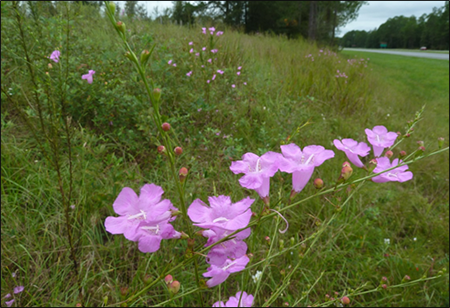
(Photograph courtesy Eleanor Dietrich.)
Typically, the rights-of-way of highway I-10 in Madison County, Florida, are mowed up to seven times a growing season. In 2009, a pilot study on a one-mile segment of the highway was initiated to look at potential effects of a reduced mowing regime on plant composition, soil erosion, expenses, and highway operations. From 2009 to the project’s completion in 2013, mowing fence to fence (or tree line to tree line) was limited to once a growing season, in the fall. A 10–15 foot wide clear zone adjacent to the pavement continued to be mowed seven times each growing season.
The vegetation was monitored over the years, and as time passed the disparity between the vegetation in the constantly mowed clear zone and the remainder of the right-of-way increased. With time, more and more desirable plant species were found in the section of the right-of-way with the reduced mowing regime. As blooming wildflowers increased, the section of the road became more aesthetically appealing, particularly in the spring.
Additionally, mowing costs were reduced by $1,000 per mile. The modified mowing regime did not increase soil erosion or have negative impacts on normal highway operations. The pilot study demonstrated that Florida Department of Transportation could experience cost savings as well as safety, aesthetic, and ecological benefits by implementing reduced mowing procedures.
Back to top
BMP 3 - Reducing the Impacts of Herbicides on Pollinators
Overview
Departments of Transportation can take a number of steps to reduce the impacts of herbicides on pollinators, including using herbicides carefully and efficiently and reducing damage to nontarget plants.
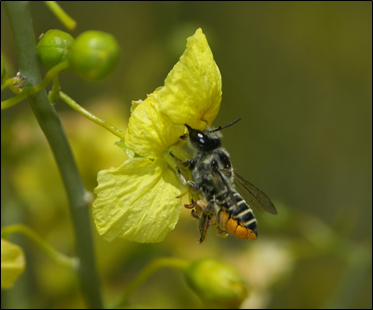
Pollinators such as this leaf cutter bee (genus Megachile), can be indirectly harmed by herbicide use through the loss of foraging plants. (Photograph courtesy the Xerces Society.)
Essentials
You can reduce the impacts of herbicides to pollinators by:
- using herbicides efficiently and effectively,
- avoiding damage to nontarget plants,
- reducing herbicide exposure to pollinators, and
- communicating with adjacent landowners.
Reducing the impacts of herbicides on pollinators
Herbicides used to control noxious and invasive weeds or encroaching woody vegetation can benefit pollinators by suppressing the undesired plants that displace the valuable native plants which provide them with food or shelter. When used indiscriminately, however, herbicides can reduce the quality of roadside habitat by removing floral resources and host plants, and may be directly toxic to some pollinators. Overuse of herbicides can also weaken stands of vegetation, making them more vulnerable to weed invasions, which also indirectly affects pollinators. There are a number of steps roadside managers can take to reduce harm to pollinators from herbicide applications. Many of these steps may also reduce long-term maintenance costs by encouraging healthy stands of roadside vegetation and by reducing the overall amount of herbicide applied.
Using herbicides efficiently and effectively
By using herbicides as efficiently as possible, roadside managers can reduce both the amount applied and their impact on plants that benefit pollinators. Inventories and record keeping, using products selectively, the careful timing of applications, and following label directions can all increase the effectiveness of herbicide use and decrease impacts to pollinators.
Herbicides may be used efficiently by:
Conducting inventories and keeping records
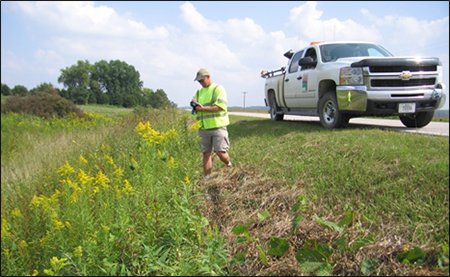
Regular inventories allow weed problems to be identified and dealt with early, resulting in less herbicide use and more protection for native plants. (Photograph courtesy Iowa Living Roadway Trust Fund.)
- Conducting inventories. Inventories of roadside vegetation can identify emerging noxious and invasive weed issues. Early action can control outbreaks of noxious and invasive plants before they have a chance to spread. Early detection and control of weeds reduces the amount of herbicide needed overall.
You can use shared databases about locations of invasive species to help find new outbreaks quickly. For example, EDDMapS (Early Detection and Distribution Mapping System) is a free online tool used by a number of land management agencies that allows anyone to upload mapping information about locations of invasive species. EDDMapS also has an app for smartphones.
- Keeping records. Records of plants treated, application method, type and amount of herbicides used, and dates of application can help to evaluate the effectiveness of treatments.
- Linking maintenance records. It is useful to incorporate tracking and record keeping systems that are linked to GPS/GIS systems with maintenance activities in order to track weed outbreaks and sensitive sites.
Using herbicide products selectively
- Using selective herbicides. The use of selective herbicides—those formulated to control specific weeds or groups of weeds—whenever possible can reduce damage to nontarget plants.
- Using nonselective herbicides selectively. Nonselective herbicides—those that are broad-spectrum and kill or damage all plants—can be used selectively to reduce impacts on nontarget plants. For example, nonselective herbicides can be used selectively by applying to weeds when desirable native plants are dormant and by using directed or targeted applications.
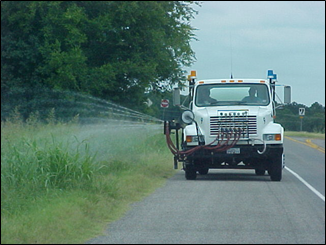
Selective application of herbicide to control Johnson grass (Sorghum halepense
). (Photograph courtesy Texas DOT.)
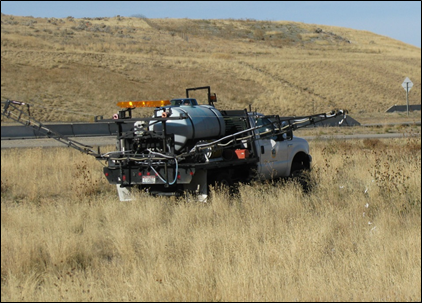
Herbicides are an important tool for managing nonnative or invasive species, but care is needed in their application to reduce disturbance to habitat areas. Simple steps, such as ensuring correct equipment calibration and not spraying when wind speeds exceed 15 mph, can minimize nontarget impacts. (Photograph courtesy Idaho DOT.)
Timing applications carefully
- Timing applications. Applications can be timed to be most effective based on the herbicide’s mode of action and the application technique. For example, when using a systemic herbicide, you can treat perennial weeds in the late summer and fall. During this period, perennials begin to move sugars down to their roots, and the herbicide will be translocated to vegetative reproductive structures, where it will be most effective at controlling the plant.
- Applying herbicides at vulnerable life stages. Applications of herbicides at the stage of growth when the weed is most vulnerable can make applications most successful. For many weeds, this will be the seedling or rosette stage.
Establishing protocols to time applications as effectively as possible within the given operational constraints of your agency can benefit pollinators and may increase efficiency and cost savings. For example, developing a control calendar that identifies key weeds and the best windows for control can help roadside maintenance crews identify the optimum time for application.
- Avoiding herbicide sprays when weather conditions increase drift. It is best to avoid applications when wind speeds are greater than 15 mph. You may also want to avoid applications during a temperature inversion (when warmer air above traps cooler air near the ground); these conditions cause herbicides and other pesticides to linger in the air, where they can move long distances offsite with any air movement.
Following label directions
- Applying herbicides according to label directions ensures correct use.
- Using the minimum concentration that will effectively control your weed.
Avoiding damage to nontarget plants
Reducing off-site movement of herbicides and nonselective broadcast applications can help you avoid damage to plants that provide pollinators with food or shelter.
Damage to nontarget plants can be reduced by:
- Recognizing weeds. Using plant identification reference materials (see Appendix A), you and your staff can recognize noxious and invasive weeds and distinguish them from similar nontarget species.
- Directing applications to weeds. In order to avoid weakening nontarget species, you can target weeds using spot treatment applications made with a backpack sprayer, weed wiper, or similar appropriate technology. Using highly targeted applications to cut stems, stumps, or under bark can reduce unnecessary impacts to desirable plants. Broadcast treatments or pellet dispersal are recommended only for dense infestations of weeds or for clear zone or guardrail treatments.
- Selecting and calibrating equipment. When selecting and calibrating equipment, it is important you consider drift management. Nozzles that produce larger droplets are less likely to drift off target. If you calibrate equipment regularly to avoid over application, you can avoid wasting herbicides and money.
- Considering wind speed. It is best to avoiding making spray applications if winds are at or above 15 mph.
- Reducing volatility. Some herbicides are volatile, meaning that after application they can turn into a vapor and move off site. To reduce volatility, herbicides with low vapor pressure can be selected. Herbicide applications can be timed when the herbicide is less likely to volatilize. For example, it is best to avoid spraying during an inversion. No wind suggests there is possibly an inversion present.
- Recognizing sensitive remnant habitat. When using broadcast treatments, it is important to maintain a buffer zone of 30 feet or more near sensitive vegetation to reduce impacts on sensitive areas. If using spot treatments, consider flagging sensitive species that need protection.
Reducing herbicide exposure to pollinators
Here are steps you can take to reduce the risk of direct exposure of herbicides, which can be toxic to some pollinators.
Pollinator exposure to herbicides can be reduced by:
- Treating weeds before they flower. This provides better control of the weed and reduces the exposure of pollinators to herbicides.
- Adjusting the timing of applications. To reduce direct contact exposure to pollinators, herbicides can be applied during a time when pollinators are less active. Many pollinators (but not all) are less active before the sun rises or after the sun sets, and are also less active at cooler temperatures (below 50 degrees Fahrenheit).
- Reducing exposure to caterpillars. Avoiding broadcast applications of systemic herbicides and herbicides with long residuals will reduce exposure to butterfly and moth caterpillars that can be poisoned by consuming contaminated vegetation.
Communicating with adjacent landowners
Communication with adjacent landowners can help reduce the spread of weeds and encroachment of herbicides onto roadsides.
Weed and herbicide encroachment from adjacent lands can be reduced by:
- Preventing encroaching weeds. Weeds from adjacent land can encroach onto roadsides, but communication with adjacent landowners may help prevent the spread of noxious weeds from their land.
- Preventing drift from adjacent land. Communicating with landowners may help prevent drift from adjacent crop field applications into roadsides, which can degrade roadside vegetation and the quality of habitat for pollinators.
- Addressing concerns about herbicide use. By working with adjacent landowners or land managers that have concerns about herbicide use (e.g., organic farms, apiaries, natural areas) you may be able to find site-specific alternatives.
Case Study: Reducing Herbicide Use on Oregon's Roadsides
In 2010, the Oregon Department of Transportation received an internal directive to reduce herbicide use, with the goal of reducing the amount of active ingredient used by 25%. Maintenance staff replaced older application equipment with updated, more efficient equipment, applied more dilute rates of application, moved to using spot sprays for noxious weeds, and avoided routine sprays. By 2015, Oregon DOT had met its objective of reducing the number of pounds of herbicide active ingredients used; in most places they have reduced it by nearly 50%.
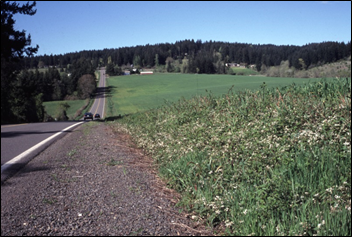
(Photograph courtesy the Xerces Society.)
Back to top
BMP 4 - Employing Multiple Vegetation Management Strategies
Overview
Vegetation management techniques commonly used elsewhere can be adapted successfully to the working conditions of roadsides.
Essentials
Conducting prescribed burns, brush removal, and prescribed grazing to benefit pollinators by:
- timing implementation of the practice carefully and
- limiting the scale of use of the practice.
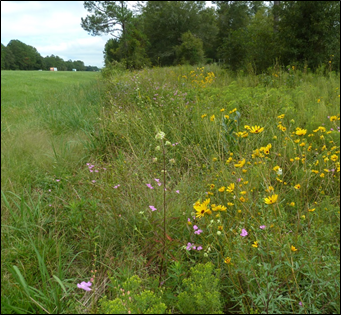
Maintaining a vibrant and healthy roadside plant community may mean seeking out management tools beyond mowing and herbicides to manage native plants, such as feathering edges of forests to open up the canopy and increase wildflowers. (Photograph courtesy Eleanor Dietrich.)
Employing multiple vegetation management strategies
Mowing and herbicides are the most frequently used roadside vegetation management tools. Prescribed burning, brush removal, and prescribed grazing are additional tools in the Integrated Roadside Vegetation Management (IRVM) toolbox. These tools may not be appropriate for all areas, but they can be highly beneficial and cost-effective under the right circumstances. These management practices can be used to increase diversity of roadside vegetation and benefit pollinators when planned and implemented with pollinators in mind.
Prescribed burns
“Burn bosses” and other fire ecology specialists can modify the use of prescribed fire as a roadside management tool by timing burn events seasonally or limiting the scale and frequency of the burns to make this management practice more pollinator friendly. Prescribed burns may be useful for rejuvenating diversity in degraded remnant prairie, meadow habitat, or forest stands. However, prescribed burns can be harmful to many pollinators and have long-term impacts on the populations of some species. For example, summer burns destroy eggs and caterpillars and remove vegetation at a time when pollinators need floral resources, host plants, and nesting materials, while winter burns destroy species that overwinter in leaf litter or stems. The scale of the prescribed fire can affect the impact on pollinators.
The impacts to pollinators from prescribed burning can be reduced by:
- Leaving unburned vegetation. It is best to use prescribed burning on sections of the roadside corridor, rather than the entire corridor. By leaving unburned roadside habitat, enough pollinators will remain to recolonize the burned areas.
- Using rotational burning. Prescribed burns conducted 3 to 5 years or more apart allow time for pollinator populations to recover. Rotational burning can provide the benefits of prescribed fire without causing irreparable damage to the local pollinator community.
- Varying the time of burns. By varying the timing of prescribed burns, you can avoid inadvertently impacting certain pollinators and components of the roadside plant community. Burns will affect pollinators no matter when they occur, so changing the timing of burns can reduce such impacts to a particular group or suite of pollinators. Prescribed fire has different impacts or benefits for the roadside plant community depending on when it occurs (Table 4.1).
Table 4.1 Timing of prescribed burns for different management objectives (not applicable in all regions and vegetation conditions).
| Management objective |
Timing of burn |
| Brush control |
Spring
- Subject to region- and species-specific information
|
| Weed control |
Late spring
- Subject to region- and species-specific information, because some weeds have a positive response to fire
|
| Stimulate wildflowers |
Early spring or fall |
| Stimulate warm season grasses |
Mid to Late spring |
| Stimulate cool season grasses |
Early spring or fall |
| Suppress cool season grasses |
Late spring |
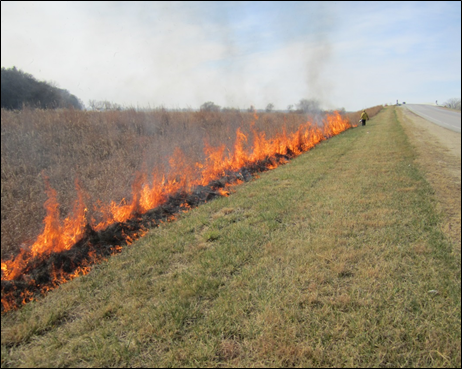
Fire has always been a natural part of Iowa’s prairie ecosystems. Now it is used as a management tool on the state’s roadsides too. (Photograph courtesy Iowa Living Roadway Trust Fund.)
Brush removal

Mechanical trimming of roadside brush and trees offers benefits to both drivers and pollinators. Problematic or dangerous trees can be removed while improving conditions for pollinators. (Photograph courtesy Iowa Living Roadway Trust Fund.)
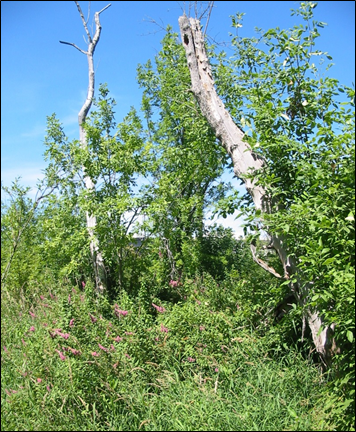
Where they can be safely retained, snags will bring multiple benefits for wildlife. (Photograph courtesy the Xerces Society.)
You can keep brush removal compatible with pollinator health by leaving brush and trees that pose no risk to motorists and by opening up the canopy along forest edges. Mechanical trimming to remove problematic shrubs or trees, or selective trimming to partially remove woody vegetation can benefit pollinators by creating opportunities for wildflowers to grow. However, complete removal of trees and shrubs is not always beneficial because many butterflies and moths use woody native plants as host plants, and some tunnel-nesting bees utilize the stems of some shrubs as nesting sites (see Appendix B for a plant list).
Brush removal can be compatible with pollinators by:
- Removing hazardous plants. Removal of any brush or trees that have the potential to be hazardous to motorists is important. This includes plants that impede sight distance, could become dangerous fixed objects, could fall onto the highway, or shade the road in winter, creating patches of ice.
- Feathering edges. Transitional areas between forest and grass can be created by feathering or softening forest edges adjacent to clear zones. Edge feathering involves thinning portions of the forest canopy along the edge next to grassy areas, removing undesirable or unhealthy trees. Periodic cutting to maintain healthy growth and an open canopy can benefit remnant patches of savanna, forest, or other habitat dominated by woody vegetation, can improve the quality of the habitat for pollinators and many birds, and can be aesthetically pleasing.
- Leaving snags. Consider leaving snags, or trees with cavities, in areas where they are set back from the road and pose no safety risk. Snags can be nesting habitat for some bees, as well as habitat for birds and bats.
Prescribed grazing
Grazing plans that include careful consideration of stocking density and timing can be effective at controlling invasive plants and compatible with pollinator conservation. Although grazing is currently an uncommonly used practice on roadsides or in mitigation areas, several states have used it effectively. Grazing using goats and sheep, which can be herded and prefer to eat broadleaf plants, can control large infestations of invasive weeds and can be effective in areas near water or in inaccessible spots such as steep slopes. Livestock grazing can harm pollinators by trampling individuals or nests and by removing host plants and flowers.
The impacts to pollinators from prescribed grazing can be reduced by:
- Creating a site-specific grazing plan. These plans are most effective when selecting grazers to best fit the site’s needs (see Table 4.2) and considering the timing of grazing, the duration, and the stocking density.
- Timing grazing carefully. It is best to introduce grazers at a time when they will preferentially feed on the undesirable species. Grazing is most effective, for example, when the weed is palatable.
- Avoiding grazing during the adult flight period or when butterfly larvae are feeding on the host plant. If declining habitat-specialist pollinators are present you can time grazing to avoid breeding and foraging periods. (For example, see figure 2.2 on page 23 for guidance on appropriate mowing times for monarch butterflies.)
- Avoiding grazing during periods when floral resources are already scarce. Grazing during these times can eliminate pollinators from sites over time.
- Determining duration of grazing. The stocking density of grazers can help to determine the duration of grazing. If your stocking density is high, it’s best to keep the duration relatively short, so that desirable vegetation isn’t impacted.
Table 4.2 Considerations for grazing on roadsides
|
Grazing animal
|
Diet preferences
|
Browsing behavior
|
Considerations for roadsides
|
|
Goats
|
Prefer woody plants, then forbs
|
Graze selectively
Will reach or climb to browse on branches
|
Can be contained by portable fencing or tethered to concentrate grazing
|
|
Sheep
|
Prefer forbs, then grasses
|
Graze selectively
|
Can be contained by portable fencing
|
|
Cattle
|
Prefer grasses, then forbs
|
Graze somewhat selectively
|
May require more heavy fencing
|
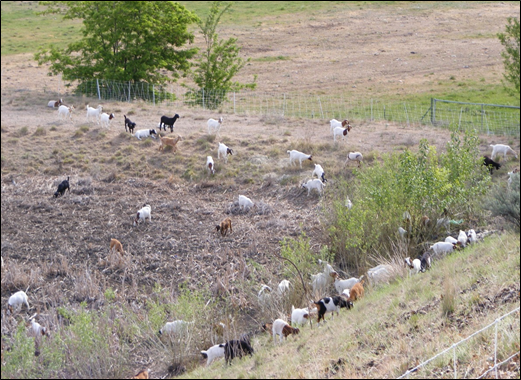
Goats are used to control unwanted species and manage vegetation on steep embankments in Idaho. (Photograph courtesy Idaho DOT.)
Back to top
BMP 5 - Designing Your Roadside Landscapes to Benefit Pollinators
Overview
Landscape designers and engineers can increase the value of roadside plantings for pollinators by including wildflowers, grasses, shrubs, and trees that provide pollinators with food or shelter, and can select plants for pollinators that do not compromise highway safety.
Essentials
You can design your roadside landscapes to benefit pollinators by:
- incorporating landscape design elements that benefit pollinators and
- selecting plants that maintain highway safety while maximizing pollinator habitat.
Designing your roadside landscapes to benefit pollinators
Many types of roadside plantings can benefit pollinators. These include erosion control or slope stabilization efforts and meadow plantings in highway rights-of-way, medians, cloverleaf interchanges, and rest areas, as well as including flowering shrubs and trees in living snow fences or ornamental plantings. The selection of vegetation in roadside plantings will significantly influence the habitat value to pollinators and can also affect maintenance and aesthetics. Roadside plantings are designed to prioritize the safety of motorists, which will not be compromised by incorporating design elements that benefit pollinators. Whether you are designing an ornamental highway planting for the entryway to a city or a seed mix to stabilize a slope, you can select plants that provide the functions that you need while also providing food or shelter for pollinators.
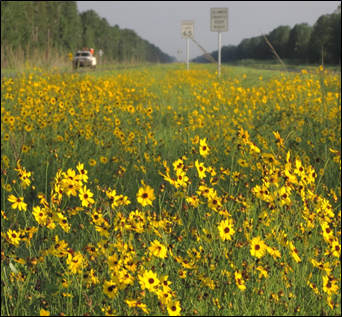
Win–win–win–win: Thoughtful landscape design can ensure that roadsides meet both ecological needs and driver safety requirements, while also reducing maintenance demands and being aesthetically pleasing. (Photograph courtesy Jeff Norcini.)
Incorporating landscape design elements that benefit pollinators
Bees, butterflies, and other pollinators need abundant sources of pollen and nectar throughout the growing season. In addition, butterflies and moths also need particular host plants on which to feed during their caterpillar stage, and some pollinators utilize grasses or the pithy stems of certain plants as nesting or overwintering habitat. Consideration of pollinator habitat needs can transform a roadside planting from a stark grassy verge to a colorful roadside humming with life. Key factors in the design of roadsides for pollinators include the use of native plants, selecting plants for pollinator attractiveness and overlapping bloom time, maximizing floral diversity and abundance, and including butterfly host plants and other pollinator resource needs.
Roadside design elements that benefit pollinators can be incorporated by:
Using Native Plants
- Prioritizing the use of native plants. Native plants can be used in all types of roadside revegetation projects. Bees and butterflies are more abundant and diverse on roadsides with native plants compared with those dominated by nonnative grass and flowers. Additionally, roadsides with native plant communities have other functional advantages (see text box) such as resiliency to weed invasions, requiring less maintenance, and showcasing a region’s natural beauty.
- Prioritizing the use of ecoregional plant species. It is best to use native plant species found within your project’s ecoregion. Ecoregions are areas of the landscape with similar landforms, soils, hydrologic conditions, and plants and animals. Ecoregional plant communities are best equipped to establish in your area and provide the most benefits to pollinators.
- Selecting plants for ornamental plantings with care. When considering pollinators, it’s best to avoid double-flowered hybrids and other ornate modern varieties or cultivars, which often produce little or no pollen or nectar as a consequence of breeding for pest or disease resistance or appearance.
- Planting selections with a focus on native plants. If using noninvasive and nonnative plants due to constraints on budget and availability of plant material, it is best to select only those species that will not spread aggressively or reduce biodiversity.
Selecting plants for pollinator attractiveness and overlapping bloom time
- Focusing on plants known to be attractive. It is important to include plants that are known to provide floral resources and attract pollinators. See Appendix A for resources on regional species lists and Appendix B for lists of plants for pollinators.
- Including plants that bloom at different times. This ensures that there is an overlapping succession of bloom throughout the growing season. For example, you can include three species that bloom in the spring, three that bloom in the summer, and three that bloom in the fall. This will provide a continuous supply of food for pollinators and will be aesthetically pleasing the whole growing season.
- Including plants that bloom very early in the spring and late into the fall. These are times when food sources can be scarce but are very important to the health of pollinators such as bumble bees, honey bees, and migrating monarch butterflies.
Increasing plant diversity and abundance
- Increasing plant diversity whenever possible. Pollinator diversity increases with increasing plant diversity. In particular, it is best to maximize the number of flowering plant species.
- Including a diversity of plants with different flower shapes, sizes, colors, and growth habits. Different pollinators have different floral needs and preferences, so this helps support the greatest abundance and number of species of pollinators.
- Emulating the plant diversity found in nearby natural communities. Diverse plantings that resemble natural communities are the most self-sustaining and long-lasting plantings because they better resist weed invasions and pest outbreaks.
- Increasing floral abundance. Whenever possible, it is best to increase the abundance of wildflowers and blooming shrubs or trees. For example, you may want to maximize the percentage of wildflowers included in a seed mix. The combination of grasses and wildflowers can effectively resist weed colonization and provide soil stabilization, but if the grass component exceeds 50% of the mix, grasses may quickly outcompete the wildflowers.
- Clumping single species together. In ornamental plantings, planting small clusters of single species of flowering plants to form patches of color when in bloom helps pollinators to spot the plants quickly. This is especially helpful for pollinators searching landscapes for limited resources and also helps pollinators to move quickly and efficiently between flowers to collect the resources they need. In larger plantings, clusters are less important as long as flowering plants are abundant.
Establishing butterfly host plants and other plants that provide pollinator resource needs
- Including host plants. It is important to include host plants of key target species of butterflies and moths. Roadsides with host plants can support habitat generalist butterflies as well as habitat specialists and migrant species such as the monarch butterfly. Establishing caterpillar host plants is recognized as a way to sustain butterfly populations, so if one of your design goals is to support the recovery of declining monarch butterflies, for example, you can include milkweed species in your mix or planting. See the resources included in Appendix A for plant species lists and information about host plants for butterflies.
- Including native grasses and sedges. Although grasses and sedges do not provide pollinators with nectar and rarely with pollen, they do provide other resources pollinators need, including host plants for many butterflies and moths, potential nesting sites for bumble bees, and overwintering sites for many other pollinators.
- Emphasizing shorter native grasses. It is best to include shorter native grasses that will not overwhelm wildflowers or grow too high and impede driver visibility. You may want to keep the density of tall dominant grasses (e.g., big bluestem [Andropogon gerardii], Indian grass [Sorgastrum nutans]) low because these grasses crowd out wildflowers more easily than do shorter grasses. Cool season grasses, those that grow actively in the spring, can also outcompete wildflowers if sown at high densities.
- Providing native shrubs and trees. There are a number of native shrubs and trees that are host plants for butterflies or moths and can serve as nesting habitat for some tunnel-nesting bees. See the resources included in Appendix A for information about host plants for butterflies. For a list of plants known to provide tunnel-nesting bees with nesting habitat, see Appendix B.
See the resources included in Appendix A for information about host plants for butterflies. For a list of plants known to provide tunnel-nesting bees with nesting habitat, see Appendix B.
Why Use Native Plants?
- Native grasses and flowers are best adapted to local growing conditions, require minimal inputs for establishment, and are able to tolerate drought or heat.
- The root systems of native plants can increase water infiltration, which reduces runoff and water pollution.
- An established diverse plant community provides the most stable cover for reducing erosion and keeping out weeds.
- Improved weed and erosion control can reduce the need to spray herbicides and to mow, thereby reducing long-term maintenance costs.
- Native plants are less likely to encroach on land bordering roadsides.
- Native plant communities can act as snow fences in the winter, trapping and preventing snow from blowing across roads.
- Native plantings are aesthetically pleasing and can support tourism
- Native plant communities support more birds, pollinators, and other wildlife.
- Wildflowers break up driver monotony, which can contribute to clearer thinking and reduce driver stress.
Case Study: Caltrans' Ecoregional Seed Mixes
Vegetation to control erosion is effective when it maintains water quality and increases infiltration by keeping soil in place and reducing runoff. Recognizing the value of native plants in controlling erosion, Caltrans, California’s Department of Transportation, uses California natives for nearly 99% of plants used in their erosion control projects.
With 19 ecoregions, ranging from coast to desert to mountains, California has extraordinary botanical diversity. To aid landscape architects in their selection of regionally appropriate native plant species for erosion control and revegetation, Caltrans has developed the plant selection tool TransPLANT (found at: http://transplant.dot.ca.gov/TransPlant.php). Elevation, soil type, regional plant communities, and rainfall are all incorporated into the tool. Landscape architects enter in information about a project’s location and are provided a list of potential species to include in seed mixes based on ecoregional classifications, project site parameters, and seed availability.
By focusing on ecoregional mixes, Caltrans controls roadside erosion using plant species adapted to the specific region and benefits from the many environmental advantages of these native plants.
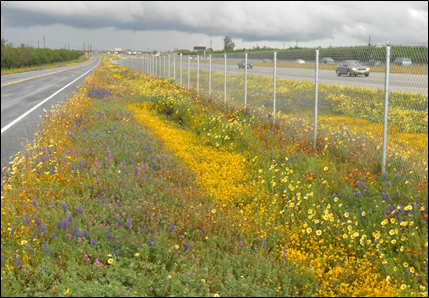
(Photograph courtesy Caltrans.)
Selecting plants that maintain highway safety while maximizing pollinator benefit
Roadside plantings are designed to adhere to design specifications for setbacks, driver visibility, and other safety concerns. Native plants that benefit pollinators can be included in roadside plantings without compromising drivers’ ability to see and to be seen or increasing the potential for collisions with large animals.
Highway safety and pollinator habitat can be made compatible by:
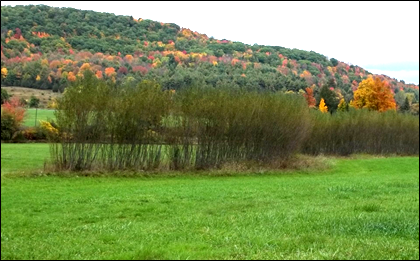
Living snow fences planted with willow can make the roads safer by reducing drifting snow during the winter, and will support wildlife in the spring and summer. (Photograph courtesy New York State DOT.)
- Avoiding tall grasses and tall wildflowers in high-crash zones or within lines of sight of intersections or around curves. For example, herbaceous tall plants such as big bluestem grass (Andropogon gerardii) or cup plant (Silphium perfoliatum) and tall shrubs such as serviceberry (Amelanchier spp.) are best when set back in the natural or buffer zone (see figure 2.1).
- Avoiding planting palatable species. It is best to avoid plant species known to be palatable to deer or other large herbivores. Because these animals can pose a risk to motorists, avoiding palatable plants can help you avoid drawing them closer to the roadway. In particular, it is important to avoid plants that are green at a time of year when other food sources for large herbivores are scarce (e.g., white clover [Trifolium repens]), as these plants may attract herbivores into the roadside.
- Maintaining a regularly mown clear zone. Maintaining this area adjacent to the pavement or shoulder helps increase drivers’ ability to see and to be seen and reduce deer–vehicle collisions.
- Installing living snow fences. Where it is regionally appropriate, these can reduce ice and drifting snow on roads, increasing drivers’ ability to see and to be seen and improving safety on roads in the winter.
Some shrubs known to be effective in living snow fences also have value to pollinators, including shrub willows (Salix eriocephala), American plum (Prunus americana), serviceberry (Amelanchier arborea) and silver buffaloberry (Shepherdia argentea). Although pollinators are not the primary consideration when selecting plants to include in living snow fences, including pollinator-friendly species when possible can increase the multiple benefits of the planting.
- Encouraging flowering plant diversity and abundance. Transportation agencies can accomplish this through design and through maintenance operations. The aesthetic variety of roadsides with wildflowers or blooming shrubs may improve highway safety by reducing driver monotony and increasing driver performance.
Back to top
BMP 6 - Adopting Proven Native Plant Establishment Methods
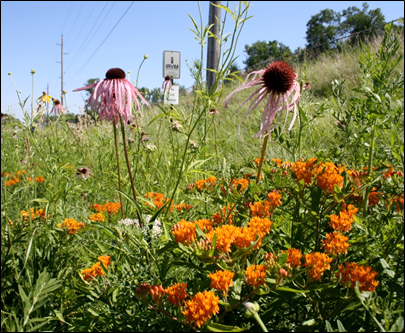
Iowa has a long history of successfully using native plants in roadside vegetation projects. This roadside is maintained under the state’s Integrated Roadside Vegetation Management program. (Photograph courtesy Iowa Living Roadway Trust Fund.)
Overview
Success in native plant establishment can be achieved by planning ahead to make sure conditions are right for planting and the right species have been selected, and by building internal restoration expertise by learning from other transportation agencies and local experts.
Essentials
You can plant your site effectively and enhance the establishment of roadside vegetation by:
- thoughtful site planning,
- sourcing the best plant material,
- using the best planting techniques for your site and conducting maintenance during establishment, and
- building revegetation expertise within your agency.
Adopting proven native plant establishment methods
Establishing plants on roadsides, including hardy native plants, is not quite as simple as scattering seed or planting a tree. There are many challenges associated with establishing plants on roadsides, including invasive weeds, disturbances, low soil quality, and timing of planting. This section includes suggestions and advice from roadside restoration experts and practitioners on the planting process and improving plant establishment.
Thoughtful site planning
Thoughtful site planning can be conducted by:
- Selecting suitable species. The first step to a successful planting is selecting suitable species. You can use vegetation inventory data or assessments of the project site’s current vegetation, soil, and climate to help you match the plant species with the environmental conditions of the site, prioritizing the species that are of benefit to pollinators. If seed mixes or plantings cannot be context-specific, include species adapted to a wide range of growing conditions. If your planting will be close to the road and road salt applications are used, you may want to select plants with some level of salt tolerance.

(Photograph courtesy Arizona DOT.)
- Selecting the most suitable planting method. You can select the method of planting that best suits your project’s goals, budget, and site conditions. Roadside vegetation can be established from seed or plant material in the form of plugs, container-grown plants, and bare-root or balled materials. Seeding is a cost-effective method but plant establishment takes more time. The use of plugs and other transplants have the advantage of rapid establishment and will flower sooner than plants established from seed. However, the cost can be prohibitive in large plantings. Additionally, transplants often undergo a period of shock during which they may need supplemental water and mulching to survive. A combination of seeding, followed by transplanting plant materials of species that are harder to establish via seed, can be effective.
- Determining when planting can occur. If your agency does not already have one, consider developing a seeding and planting calendar for your region that includes the best times to plant for survival and growth of plants.
If installing transplants, the best planting windows are in early spring when there is adequate soil moisture or in the fall when dormant plants can be installed. If installing in summer, irrigation is often necessary. Some areas in the arid west may not be conducive to planting transplants at any time of year unless you can add supplemental water.
The window to install seeds varies between sites and is influenced by temperature and moisture levels, but seeding is generally best done in the dormant season to aid the establishment of species that require an extended period of stratification in order to germinate, or in the spring to allow seeds to germinate and establish before winter.
- Coordinating with plant vendors. It is best to communicate in advance with local or regional native plant vendors about your plant material needs. It may be necessary to allow time for vegetation to be grown out for the purpose of planting at a particular site.
- Developing a weed management plan. This is useful for site preparation before planting and for weed control during the establishment phase.
- Salvaging desirable vegetation. Desirable vegetation can be salvaged from the site before construction or disturbance begins. You can enlist the help of other agencies or volunteers to temporarily relocate the salvaged vegetation.
- Coordinating within your agency. It is important to work with engineers to integrate your revegetation or landscape planting plans, and coordinate with maintenance staff about site preparation needs and future vegetation management needs for the site.
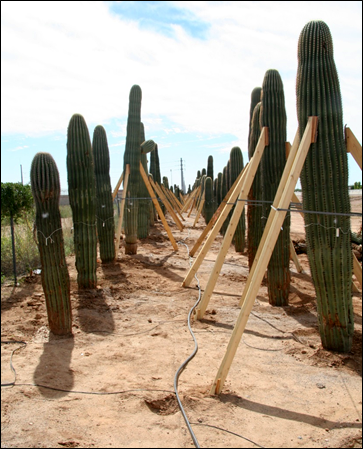
Existing native vegetation can be relocated prior to construction, particularly less common plants or those that are significant landscape elements. These saguaro cacti were moved from an Arizona construction site and kept alive in a temporary nursery until they could be returned. Ironwood trees were also relocated during this project. (Photograph courtesy Arizona DOT.)
Case Study: Establishing Native Plants in Arizona
Arizona DOT (ADOT) has a long history of effective native plant establishment on roadsides. Although in prior years the use of native plants had been sporadic, the transition from nonnative to native species began in earnest in the 1980s. By 1992, ADOT was using only native species in roadside revegetation projects.
State maps of biotic communities were used to draft plant species lists. Using lists of species grouped by ecoregion, ADOT cross-referenced the lists with commercially available plant material. Over the years, the availability of native plant material, particularly seed, has increased greatly. The consistent and sustained use of native grass and wildflower seed for ADOT projects has motivated native seed growers to expand the market and to keep costs affordable. Currently, native seed growers are able to review ADOT’s five-year plans, giving them an idea of future demand.
ADOT has avoided use of single-species mixes, as well as grass-only mixes, with the result that the state’s roadsides are diverse and flower-rich. In every seeding specification, ADOT emphasizes a broad spectrum of species. For example, a typical project uses a diversity of 15–25 species, including a mix of annual, biennial, and perennial wildflowers, some shrubs, and 3–5 species of native grasses. After observing that in plantings composed of a mix of 50% grass and 50% wildflowers/shrubs the grasses outcompeted the flowers, and even the shrubs over time, ADOT scaled back the proportion of grasses to 25% to allow flowers to proliferate.
ADOT is also proactive when it comes to the plant establishment process, controlling weeds that may pose a threat to the establishment of the desired native plants. For example, ADOT includes control of noxious and invasive species in construction specifications, the first state DOT to adopt this approach. In practice, this specification means that noxious and invasive weeds are controlled before, during, and after an area is disturbed by construction. To reduce the introduction of unwanted species during the planting process, ADOT uses clean compost (no manure or biosolids) and certified weed-free straw. Seeds are required to be supplied in separate packages for each species rather than pre-mixed. ADOT requires a seed testing certificate showing germination percentage and any contaminant species. ADOT reviews the seed certificates and rejects those contaminated with undesirable species. The specifications also provide a replacement cost for each species to discourage substitutions with seeds of less expensive species. By proactively controlling problematic weeds that can outcompete beneficial plants, these practices help desired species establish quickly and effectively and maintain the long-term integrity of roadside plantings.
Sourcing the best plant material
The information below can help you determine the best sources for your plant materials.
Plant material can be sourced by:
- Prioritizing local ecotypes. It is important to prioritize the use of plant materials that are sourced from local ecotype providers. Plant materials that originated in geographic proximity to the project site are best adapted for local conditions and pollinators. The bloom times of non-locally sourced plants have the potential to be out of sync with pollinators, especially specialist pollinators that are reliant on the pollen from a small subset of plants and time their emergence annually with the bloom time of their host plants.
- Locating the materials you need. You can communicate with plant vendors to obtain locally sourced seed or plant material in sufficient quality and quantities for your project. If you coordinate with them in advance, some vendors can grow out the needed plant material.
Regionally sourced native plant material can be used when there is insufficient abundance and diversity of locally sourced species.
- Requiring seed testing. It can be useful to require a seed testing certificate for each species in your seed mixes. Commercially procured seed is sometimes certified to guarantee a number of quality standards, including proper species, germination rate, and any amount of weed seed or inert material. You may want to review the certificate and return any seed to vendors that contain undesirable species as contaminants that might pose a risk to your planting.
Case Study: Iowa's Natural Selections Program Increases Iowa Native Seed

(Photograph courtesy Iowa Living Roadway Trust Fund.)
The Natural Selections program was formed to build the native seed industry in Iowa to meet the demands for high-quality, regionally adapted, and genetically diverse sources of native seed for prairie restorations, including roadside restorations. For native regional seed to be priced to compete with cultivars, it has to be produced in commercial quantities. The Natural Selections program is a collaboration of state and federal agencies, as well as private corporations. Past or present partners include the Iowa Crop Improvement Association, the Living Roadway Trust Fund administered by Iowa DOT, USDA Natural Resources Conservation Service Elsberry Plant Materials Center, the University of Northern Iowa, and independent seed producers.
Seed is collected by hand from remnant populations by the project manager and by volunteers throughout the state. The remnant populations are on roadsides, in natural areas, and on private land in three regional zones within Iowa. Iowa's Natural Selections program uses provenance zones large enough to support a market but narrow enough to retain regional distinctiveness. Collectors do not collect seed to intentionally select for certain traits. Foundation seed plots at the University of Northern Iowa amplify the seed, which is then further increased. Once seed has been increased, it is released to qualified native seed growers with production certified by the Iowa Crop Improvement Association. About 6-8 years after the initial collection, enough seed is available to sell to the public.
Successes of the project include increasing seed of 70 species, with nearly 120 ecotypes of 60 species released for commercial production, and 180,000–200,000 pounds of ecotype source-identified seed produced annually. More information can be found at http://www.tallgrassprairiecenter.org/natural-selections.
Using the best planting techniques and maintenance during establishment
This general information about planting and follow-up maintenance methods will help increase successful plant establishment. See resources in Appendix A for additional technical information.
Sites can be successfully planted and maintained by:
Careful site preparation
- Preparing your site. Site preparation of your planting area can reduce competition with invasive, noxious, or undesirable plants that would otherwise pose a threat to the establishment of your desired vegetation. Many DOTs, for example, include noxious and invasive species control in construction specifications, so that those weeds are controlled before, during, and after construction.
- Removing perennial weeds. Weeds can be removed prior to planting through herbicide applications or by repeated mowing followed by disking. You may want to focus on removing perennial weeds, which are harder to control after planting.
- Creating a planting bed. Depending on your planting method, you may want to smooth the site or rough it up prior to planting.
Effective seeding techniques
- Selecting a seeding method. It is important to select the method of seeding that is most appropriate for your site. See Table 6.1 for an overview of the advantages and disadvantages of the three main seeding methods.
- Planting your site. After preparing your seedbed, you can plant into your site. See Table 6.2 for tips on seeding techniques for the three main seeding methods.

Hydroseeding can be done from the shoulder. (Photographs courtesy Iowa Living Roadway Trust Fund.)
- Ensuring seed to soil contact. You can increase establishment by ensuring that seeds are placed into direct contact with soil during planting and are not buried more than ¼ inch deep. If needed, you can tamp or press down the seed lightly into the soil using a tractor or cultipacker after planting.
- Including nurse crops when needed. If your site requires rapid plant establishment, including nurse or cover crops in seed mixes can help hold the soil while native species establish. Some recommended nurse crops include sterile hybrids or annuals such as oats (Avena sativa), winter wheat (Triticum aestivum), or rye (Lolium multiflorum).
- Coordinating with maintenance staff. Maintenance staff can conduct weed control during the establishment phase, which can increase successful establishment. See Table 6.3 for a general timeline of plant establishment. Weed control is critical in the first and second years after planting and it is important to prevent weeds from going to seed.
- Providing weed control during establishment. Mowing during the establishment phase can help to keep weeds from shading out new native seedlings, which are small in the first year or two. Mowing at a height of 10" or more several times during the first growing season will reduce weed competition while allowing native seedlings to grow. You may also want to use spot-sprays of herbicides as needed. See Table 6.3 for a general timeline of plant establishment.
- Installing signage. Because roadsides planted with seed can take time to establish, it may be helpful to install a sign to indicate the site is a planting that is underway.
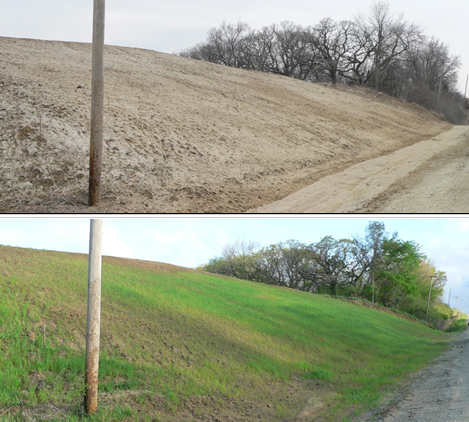
This site was planted in September. During the dormant season (top photo, taken the following March) and early on in the establishment phase (bottom, taken in April), drivers may wonder what is happening. On-site signage can answer drivers’ questions. (Photographs courtesy Iowa Living Roadway Trust Fund.)
Table 6.1 An overview of the pros and cons of methods for planting seed mixes on roadsides
| Seeding method |
Pros |
Cons |
|
Broadcast seeders or hand broadcasting
Throwing seed
|
Inexpensive
Easy to use
Equipment commonly available
Useful for species with fine seed
|
Difficult to spread seed evenly over site
Seed bed must be smooth
|
|
Drill seeding
Using a native seed drill
|
Convenient for planting large level areas
Can plant into areas with light stubble
Seed does not need to be pressed into the soil
Can control depth at which seeds are planted
|
Expensive, not readily available in some areas
Requires an experienced operator
Does not work well on slopes
|
|
Hydroseeding
Spraying the area with a mix of water, mulch, and seed
|
Useful for bridge approaches, slopes, culverts, and wet areas because it reduces soil erosion
The project can be seeded from the shoulder
Colored mulch can keep public happy while plants establish
|
Time consuming
Hydromulch is expensive
Seeding rate is hard to control
|
Table 6.2 Methods for planting seed and the techniques involved
| Seeding method |
Site preparation |
Seeding techniques |
Following seeding |
|
Broadcast seeders or hand broadcasting
Throwing seed
|
Remove as much stubble as possible prior to planting to create a smooth, lightly packed seedbed.
Seed before a rain
|
Bulk up seed using an inert carrier, such as sand or clay-based kitty litter
Make multiple passes to scatter seed over the whole site
|
Pack the seed into the soil using a tractor or cultipacker
|
|
Drill seeding
Using a native seed drill
|
Can plant into stubble
|
Plant when the soil is dry enough to prevent sticking to parts of the drill
Set depth controls to plant no deeper than 1/4 inch
|
Make multiple passes with the drill to pack the seed in well
|
|
Hydroseeding
Spraying the area with a mix of water, mulch, and seed
|
Bare ground needed, but seedbed does not need to be smooth
Seed after a rain
|
Make two passes with the hydroseeder, one in each direction, for better coverage
Seed the area furthest from the road first
|
Nothing required
|
Table 6.3 What to expect following seeding: A general timeline for native plant establishment
| Year |
Appearance |
Maintenance required |
|
1
|
Roadside will look messy; annual or biennial weeds may be present
|
Mow as needed at a height of 10" or more to suppress weeds while allowing native plants to grow
|
|
2
|
Many grasses will be growing; a few wildflower species that establish quickly may bloom
|
Mow once or as needed to suppress weeds and give natives the competitive advantage
|
|
3
|
The roadside will begin to look like a meadow
|
Use spot mowing or herbicides as needed to control weeds
|
|
4+
|
Recognizable as a meadow
|
Largely self-sustaining, with minimal maintenance needed to reduce woody encroachment or any invasive weeds
|
Effective transplanting techniques
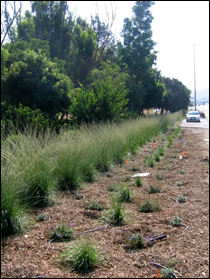
Transplants will need post-planting care. This planting in California has been mulched to suppress weeds and retain moisture and has drip irrigation to supply each plant with water during the establishment period. (Photograph courtesy Caltrans.)
- Determining equipment needed. You may require particular equipment for the installation of your transplants. Shovels are often adequate for excavating holes for many transplants but power augers are a particularly efficient way to create a hole for large container stock. Steep or rocky slopes may require specialized planting equipment, such as expandable stingers.
- Staging your planting before digging holes. Your project’s objectives will determine the planting patterns, whether transplants will be spaced out evenly, in clumps, or at random. Remember to consider the size of each species at maturity when spacing out plants. For example, most woody shrubs should be spaced on 4 foot to 10 foot centers to give them ample room to grow.
- Adding compost to holes prior to planting. In areas where soil is compacted or degraded, you can increase plant establishment by adding compost to holes prior to planting. It is best to use clean compost (i.e., weed free and without manure or biosolids) to reduce the introduction of unwanted weeds during planting.
- Using mulch. It can be helpful to spread weed-free bark or wood chip mulch or straw around the plants to reduce weed competition and to hold in moisture.
- Irrigating the transplants thoroughly immediately after planting. Depending on weather, region, and site conditions, regular follow-up irrigation may be needed but can usually be discontinued a year or two after establishment. Some nonnative plants may require longer periods of irrigation.
- Installing netting or other plant guards where needed. This can help protect transplants from browsing animals that can cause significant damage.
Building revegetation expertise within your agency
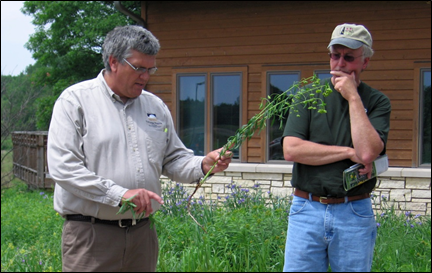
Transplants will need post-planting care. This planting in California has been mulched to suppress weeds and retain moisture and has drip irrigation to supply each plant with water during the establishment period. (Photograph courtesy Caltrans.)
Not every transportation agency has internal expertise with native plant establishment, and even agencies that are comfortable with establishing native shrubs and trees may be less comfortable with establishing wildflowers.
Revegetation expertise within your agency can be supported by:
- Conducting trainings. Trainings can build expertise within your agency and can include local, state, or federal agencies or conservation organizations or other state transportation agency staff to share ideas and learn from each other’s experiences.
- Creating partnerships. By partnering with local organizations or experts on small trial projects, you can test out various revegetation or planting strategies. Then, you can build on your successes by expanding to larger areas.
- Developing state or regional protocols for staff or contractors. As appropriate to your agency’s policies, developing standard operating procedures can be a way to take staff and contractors step-by-step through specific seeding or planting processes that are best for your region.
Reducing Costs and Finding Funding to Support the
Use of Native Plant Materials
Obstacles facing transportation agencies seeking native plant materials can include the cost and, depending on region, the availability of locally sourced native plant materials. Some solutions that transportation agencies have used to fund plant material purchases or increase the supply of native plant material include:
- Committing to purchasing and planting seed or plant material that originates in your state or region. You can coordinate with local or regional native plant vendors about plant material needs for projects 3–5 years in the future, so the vendors can plan ahead to have the plant material available. Such a sustained commitment fosters a stable market that will lead to greater production and reduced costs.
- Partnering with private nurseries or state agencies in a cooperative effort to build up a local plant material industry.
- Using federal funding to purchase native plant materials. Planting native vegetation is eligible for federal-aid highway funds.
- Finding alternative sources of funding to support the planting of roadside wildflowers. For example, your state might offer a specialty wildflower license plate, the sales of which support the purchase and installation of wildflowers on roadsides. Or your transportation agency could partner with a state or local organization that obtains funding from the FHWA’s Surface Transportation Block Grant Program to implement vegetation restoration.
Back to top
BMP 7 - Raising Public Awareness
Overview
Engaging and informing the public can significantly help to build public support for your transportation agency’s roadside restoration efforts.
Essentials
You can generate public support for roadside restoration programs by:
- spreading educational information through a number of avenues and
- producing effective restorations that can serve as examples of successes.
Raising public awareness
Public support is an important component of roadside vegetation management programs. There are some hurdles of public opinion to overcome associated with the use of native plants on roadsides. Some people are less tolerant of the aesthetics of roadside plantings in the early stages of establishment than turf roadsides, and a subset of the public may perceive wildflowers negatively. Some landowners adjacent to roadsides may worry native plants will become weeds on their land, and may mow down or spray out roadside wildflowers and decrease the quality of roadside plantings. Transportation agencies need to increase public awareness about the ecological and economic benefits of using native plants along roadsides as well as other sustainable roadside management practices.
Public awareness can be increased by:
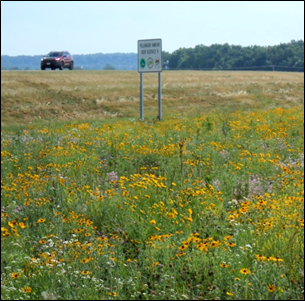
One factor in the success of the Bee Pollinator Habitat Project in Ohio was the level of public support it engendered. A highly visible location was chosen and obvious signs informed passing drivers of what was happening. (Photograph courtesy Ohio DOT.)
- Disseminating information about native plants and their benefits. You can communicate the many benefits of native plants to pollinators and roadsides via web resources, posters, brochures, and signage on roadsides and at rest areas.
Signage can indicate plantings in progress, which can help to manage public expectations of plantings that are early in the establishment process (see Table 6.3).
- Giving presentations to civic groups and at community meetings. Attending community gatherings can be an effective way to gain the support of local residents. You can develop a series of native pollinator public service announcements for local television and radio and work to place articles in local media outlets.
- Forming partnerships. Having diverse partnerships with other organizations or agencies to provide education and outreach about native plants can increase the audiences you reach. You may want to identify groups that are natural allies, such as native plant societies, local garden clubs, tourism organizations, highway sponsorship programs, state agencies (e.g., departments of natural resources or fish and game) or federal partners such as the Natural Resources Conservation Service and federal land management agencies in your state.
- Offering promotional items. Items for purchase, such as license plates, wildflower handbooks, calendars, seed packets, and t-shirts, can spread awareness and provide funding to support the use of native plants.
- Incorporating native plants into tourism campaigns. Wildflower tourism is promoted in a number of states.
- Locating showy and colorful demonstration plantings strategically in visible areas. These may include rest areas, scenic byways, or cloverleaf interchanges.
Case Study: Ohio DOT's Bee Pollinator Habitat Program
Ohio’s roadsides are predominately planted with nonnative cool-season grasses and very few remnant prairie roadsides remain. In fall 2013, Ohio DOT’s District 9 initiated a roadside restoration project to convert grassy rights-of-way to pollinator habitat. The Bee Pollinator Habitat Project is led by Ohio DOT’s Dianne Kahal-Berman, who initiated the project with members of other state agencies as part of an Ohio Certified Public Managers Program class. Pollinator decline played a driving role in the formation of the project. “If we don’t do anything about the loss of pollinators, the alternative scenario is unacceptable,” said Kahal-Berman.
Kahal-Berman spearheaded the project, believing that DOTs could play a key role in reversing declines by providing habitat and education to the public. “It is important to let people know pollinators are important to them, and that as a DOT we have the resources in terms of land to help pollinators. We just need to generate excitement about it,” she said. “We feed the pollinators so that they can feed us.”
As a first step, Kahal-Berman located two one-acre sites that were highly visible to the public along State Route 207 adjacent to the Ross County fairgrounds. The sites were also not overrun with invasive species, making the restoration process more manageable. She also sought out internal and external support, holding stakeholder meetings in the area to provide some education and engagement with the public. Since Ohio DOT did not have a great deal of experience with prairie establishment, they sought expertise from experts, including retired FHWA restoration ecologist Bonnie Harper-Lore and a local chapter of Pheasants Forever, to learn from their experiences with plant establishment.
The project has developed a web site, where several brochures and handouts are available for download, including planting guidelines, a poster about the prairie plants used in the seed mixes, and information about obtaining Ohio plant material. The web site is at https://www.transportation.ohio.gov/programs/polliantor-habitat-program/pollinator-habitat-program#page=1.
Although the program is in its beginning stages, Kahal-Berman has seen a great response, both internally at Ohio DOT and from the public. Scott Lucas, Head Maintenance Administrator at Ohio DOT, has enthusiastically lent his support to the Bee Pollinator Habitat Project and also has initiated a successful statewide project to plant sunflowers along highways for beautification and as food for pollinators and birds. The hope is that the restoration project will inspire additional roadside plantings to protect Ohio’s pollinators; there are indications that additional habitat will be established in Ohio DOT’s other districts.
Back to top
BMP 8 - Training Your Staff
Overview
Staff training about implementation of management practices that benefit pollinators, how to incorporate pollinator habitat elements when designing new roadside plantings, and background knowledge about why the practices are undertaken can make management programs more successful and efficient.
Essentials
You can provide staff with training that includes:
- background information about pollinators and the role of roadsides in pollinator conservation,
- guidance for the implementation of management techniques that benefit pollinators,
- guidance about design elements to benefit pollinators and native plant establishment, and
- information about long-term economic and ecological value of native plants.
Training your staff
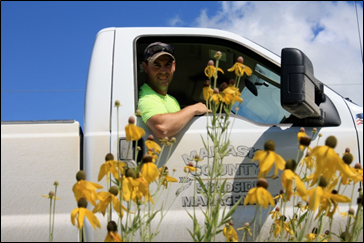
Training workshops for staff and project partners increases skills and improves the efficiency and success of projects. (Photograph courtesy Kirk Henderson.)
Training is crucial in getting staff up to speed about management practices and design elements that benefit pollinators. Transportation agency staff, including landscape designers, administrators, engineers, and public relations staff can help the success of pollinator efforts when they receive training about the use of plants that benefit pollinators on roadsides. Training can also increase the efficiency and effectiveness of roadside management and facilitate communications between functional units within DOTs, as well as communication with the public.
Training can be effective by:
- Providing training for staff at all levels. Maintenance staff, design staff, engineers, and management of state transportation agencies can all benefit from training about pollinators. Training can include background information about the importance of pollinators, the importance of roadsides to pollinator conservation, steps to take to design pollinator-friendly roadsides, effective plant establishment, and maintenance strategies that can support pollinators. See text boxes on following pages for descriptions and suggested sample agendas for full-day training events.
You may want to include background about the ecological benefits and potential cost savings of management practices that benefit pollinators, such as adjusting mowing practices or the use of native plants. This information can help increase internal acceptance of changes to management practices.
It is important to include talking points to the public, including guidance to staff on effective coordination with adjacent land owners, in your training to help staff promote the advantages of the vegetation management program, answer questions, and resolve any complaints or problems.
It is especially useful to provide maintenance staff, design staff, engineers, and management of transportation agencies with training on the value of reduced mowing and how to conduct it.
It is essential to provide regular staff training to improve the efficacy of herbicide use for those who use these chemicals. Training may include type of herbicides to use, timing of applications, application methods, drift reduction, tracking and record keeping, new technology, and emerging weed issues.
- Including plant identification. It is important that training includes plant identification of invasive weeds and native vegetation. Field identification guides and pocket guides are very useful tools. Some noninvasive, native plants that are valuable to pollinators can mistakenly be identified as weeds.
- Conducting a portion of the training in the classroom and a portion outside. This is a good way to provide a hands-on approach to applying techniques learned in the classroom.
- Bringing in outside expertise to conduct portions of the training. You may want to hire experts in pollinator biology and/or restoration ecology and invite staff from other transportation agencies and representatives from state or federal agencies or organizations.
- Offering continuing education credits. This is a good way to encourage participation.
- Including brainstorming sessions. In order to develop research questions and goals related to aspects of roadside management and design for pollinators, brainstorming sessions can be included. These sessions might include topics such as timing of mowing, the use of prescribed burning, or testing seeding rates or seed mixes.
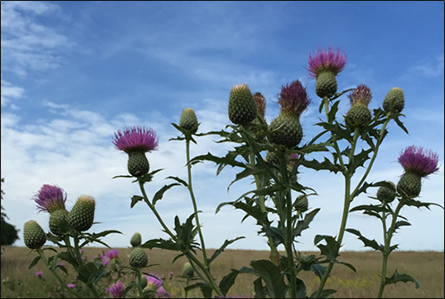
Weed or wildflower? Native thistles, such as the tall thistle (Cirsium altissimum) shown here, are valuable pollinator plants, and yet are often confused with nonnative invasive species and destroyed. Staff training in plant identification can correct this. (Photograph courtesy the Xerces Society.)
Example training workshop descriptions: Roadside maintenance and landscape design
The following pages have outlines of two sample training workshops that illustrate the content and benefits that can be gained from a one-day training event. The contents of these workshops are tailored to the needs of transportation agencies at the state, county, city, and township level, as well as landscape designers, natural resource specialists, non-governmental conservation organization staff, and land managers.
The first workshop addresses vegetation management and is targeted at roadside operations managers and maintenance staff. The second is for landscape architects, to help them (and the roadside operations managers they work with) to design and implement practices that benefit pollinators.
Sample Workshop Outline: Roadside Vegetation Management for
Pollinator Conservation
This Roadside Vegetation Management for Pollinator Conservation Workshop will provide technical information to help roadside operations managers and maintenance staff to implement management practices that benefit pollinators.
Training skills and objectives
- Knowledge of basic pollinator biology and habitat needs
- Knowledge of the economics of insect-pollinated crops, and the effects of pollinator decline
- Knowledge about the role roadsides can play in pollinator conservation
- Ability to identify ways of increasing and enhancing pollinator diversity through roadside vegetation management
- Ability to develop and implement reduced mowing regimes
- Knowledge of the current best management practices that minimize impacts of herbicides on pollinators
- Ability to incorporate pollinators into long-term roadside management decisions
- Ability to address questions from the public
Course agenda
Module 1 Introduction: The Importance of Pollinator Conservation
- Pollination biology
- Pollination economics
- Pollinators in decline
Module 2 Basic Bee and Butterfly Biology
- Pollinator recognition
- Identifying pollinator habitat
Module 3 Pollinator-Friendly Roadside Management Overview
- The value of natural habitat
- Conducting inventories
Module 4 Adapting Mowing Practices
- Adjusting the frequency and timing of mowing
- Other mowing practices
Module 5 Use of Herbicides to Reduce Risks to Pollinators
- Reducing off-site movement
- Weed recognition and timing of applications
Module 6 Open Laboratory (outdoors, weather permitting)
- Field observation of pollinators and plants, native plant selection, management discussion, and future research needs
Module 7 Additional Resources
Module 8 Wrap Up
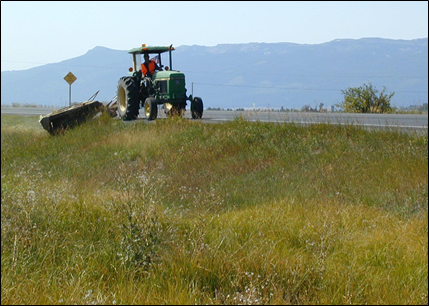
(Photograph courtesy Idaho DOT.)
Sample Workshop Outline: Roadside Landscape Design for
Pollinator Conservation
This Roadside Landscape Design for Pollinator Conservation Workshop will provide technical information to help landscape architects and the roadside operations managers they work with to design and implement practices that benefit pollinators.
Training skills and objectives
- Knowledge of basic pollinator biology and habitat needs
- Knowledge of the economics of insect-pollinated crops, and the effects of pollinator decline
- Knowledge about the role roadsides can play in pollinator conservation
- Ability to identify ways of increasing and enhancing pollinator diversity through landscape design
- Ability to design and implement roadside habitat improvements, such as native plant restoration and nest site enhancements
- Knowledge of the current best management practices that minimize impacts of herbicides on pollinators
- Ability to incorporate pollinators into long-term roadside management decisions
- Ability to address questions from the public
Course agenda
Module 1 Introduction: The Importance of Pollinator Conservation
- Pollination biology
- Pollination economics
- Pollinators in decline
Module 2 Basic Bee and Butterfly Biology
- Pollinator recognition
- Identifying pollinator habitat
Module 3 Roadside Design Considerations
- Plant selection
- Sourcing plant material
- Prioritizing motorist safety
Module 4 Enhancing Establishment of Roadside Vegetation
- Site preparation
- Planting techniques for woody and herbaceous plants
Module 5 Overview of Pollinator-Friendly Roadside Management
- The value of natural habitat
- Reducing the impacts of mowing
- Reducing the impacts of herbicides
Module 6 Open Laboratory (outdoors, weather permitting)
- Field observation of pollinators and plants, native plant selection, design discussion, and future research needs
Module 7 Additional Resources
Module 8 Wrap Up
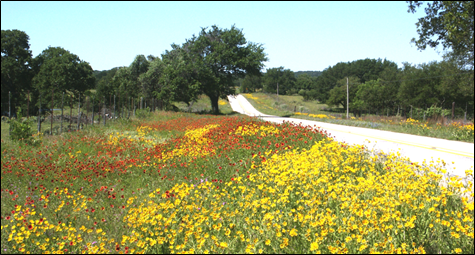
(Photograph courtesy Texas DOT.)
Back to top
Final Summary: Roadsides and Pollinators can go Hand in Hand
With thoughtful management, roadsides can provide our nation’s critical pollinators with millions of acres of much-needed habitat. Pollinators will benefit from transportation agencies that adjust the frequency and timing of vegetation management to augment floral resources, and from the enhancement and restoration of native vegetation to roadside habitat. Managing roadsides to benefit pollinators confers many other benefits, including showcasing natural beauty and promoting tourism, reducing maintenance and increasing the potential for cost savings, and supporting a wide range of important ecosystem services, including carbon sequestration. Although not often recognized as natural resources, roadsides can be an integral part of our landscape that can contribute to the health of our agricultural and natural ecosystems.
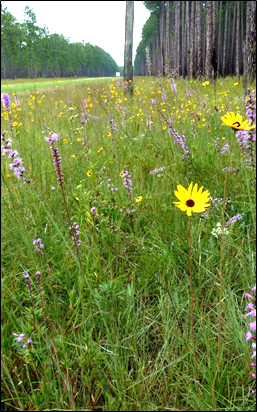
Encompassing more than 17 million acres of land in the United States, roadsides can offer great benefits to pollinators when thoughtfully planned and managed. (Photograph courtesy Eleanor Dietrich.)
Back to top
Appendix A: Pollinator and Vegetation Resources
Below are some resources for implementing pollinator-friendly roadside management practices. These and other resources may also be available through the Federal Highway Administration’s pollinator resource page: https://www.environment.fhwa.dot.gov/ecosystems/vegmgmt_pollinators.asp
Vegetation Management
Guidelines for Vegetation Management
From the American Association of State Highway and Transportation Officials and based on the experience of roadside managers, this manual includes information about weed control, erosion control, native plant establishment, prescribed burning, and other vegetation management techniques.
https://bookstore.transportation.org/item_details.aspx?ID=1752
How to Develop and Implement an Integrated Roadside Vegetation Management Program
This guide to integrated roadside vegetation management, prepared by the National Roadside Vegetation Management Association, is geared towards roadside authorities at the state, turnpike, parish, county, city, and township level.
http://www.dot.state.mn.us/environment/pdf/irvm_howto.pdf
Introduced, Invasive, and Noxious Plants
This website includes federal and state noxious weed lists, invasive plant lists, and introduced plant lists, with links to more information.
https://plants.usda.gov/java/noxiousDriver
Roadside Weed Management
Invasive species prevention and control, as well as state-by-state weed lists, and a primer on restoration are included in this book. A portion of the book is available as a PDF from:
http://www.weedcenter.org/store/docs/books-brochures/roadside%20weed%20management.pdf
United States Department of Agriculture's National Invasive Species Information Center
This website has a compilation of fact sheets and identification guides for invasive plants.
https://www.invasivespeciesinfo.gov//
Vegetation Control for Safety: A Guide for Local Highway and Street Maintenance Personnel
This manual discusses the maintenance of roadside vegetation for traffic and pedestrian safety.
http://safety.fhwa.dot.gov/local_rural/training/fhwasa07018/
Vegetation Management: An Ecoregional Approach
This handbook for managers, edited by Bonnie Harper-Lore, Maggie Johnson, and William Ostrum, is one of FHWA’s resources for considering ecoregional contexts in roadside vegetation management.
https://www.environment.fhwa.dot.gov/ecosystems/veg_mgmt_rpt/vegmgmt_ecoregional_approach.asp
Native Plants and Restoration
A Manager’s Guide to Roadside Revegetation Using Native Plants
This guide is a resource for engineers and managers seeking to implement native revegetation projects.
https://www.fs.fed.us/wildlifecrossings/library/documents/MangersGuidetoRoadsideRevegetationUsingNativePlants.pdf
Lady Bird Johnson Wildflower Center
The Center’s Native Plants Database is searchable by plants by state, as well as plant characteristics such as height, soil moisture, and value to pollinators. The Special Collections section of the Native Plants Database includes lists of plants that are attractive to native bees, honey bees, and other beneficial insects.
http://www.wildflower.org/plants/
PlantNative
This website includes directories of native plant nurseries and professionals, as well as regional lists of species that are commercially available.
http://www.plantnative.org
Restoration, Nurseries, and Genetic Resources
This website, from technical specialists with USDA Forest Service, has resources about growing native plants, including a national seed and nursery directory, and many publications about propagation and plant establishment.
http://www.rngr.net/
Roadside Revegetation: An Integrated Approach to Establishing Native Plants
This manual provides information on native plant establishment from project planning though to post-installation monitoring.
http://www.nativerevegetation.org/
Roadside Use of Native Plants
A reference that includes lists of native trees, shrubs, vines, grasses, and forbs for each state.
http://www.environment.fhwa.dot.gov/ecosystems/vegmgmt_rdsduse.asp
Pollinators and Roadsides
Literature Review: Pollinator Habitat Enhancement and Best Management Practices in Highway Rights-of-Way.
This literature review was developed to inform this BMP document, and is a detailed account of the research relating to use of roadsides by pollinators and vegetation management practices.
http://www.environment.fhwa.dot.gov/ecosystems/documents/pollinators_BMPs_in_highway_ROW.asp.
Pollinators and Roadsides: Best Management Practices for Decision Makers
This publication synthesizes pollinator conservation science and outlines roadside management practices that can benefit pollinators.
https://www.environment.fhwa.dot.gov/ecosystems/Pollinators_Roadsides/BMPs_pollinators_roadsides.asp
Pollinator Plant Resources and Pollinator Biology
Attracting Native Pollinators: Protecting North America’s Bees and Butterflies
A guide to pollinators, including profiles of commonly encountered bee genera and more than 50 pages of fully-illustrated plant lists (2011, Storey Publishing).
https://xerces.org/announcing-the-publication-of-attracting-native-pollinators/
Gardening for Butterflies: How You Can Attract and Protect Beautiful, Beneficial Insects
A guide to providing habitat for butterflies with 90 pages of fully-illustrated native plants that benefit butterflies (2016, Timber Press).
http://www.timberpress.com/books/gardening_butterflies/the_xerces_society/9781604695984
Pollinator Conservation Resource Center
The Resource Center includes regional information on plants for pollinator habitat enhancement, habitat conservation guides, nest management instructions, bee identification and monitoring resources, and directories of native pollinator plant nurseries.
https://xerces.org/pollinator-resource-center/
Pollinator Habitat Installation Guides
These regional guides provide describe how to install and maintain foraging and nesting habitat for pollinators and include region-specific plant recommendations.
https://xerces.org/pollinator-conservation/agriculture/pollinator-habitat-installation-guides/
Regional Pollinator Plant Lists
A resource for finding native plants that are highly attractive to pollinators such as native bees, honey bees, butterflies, moths, and hummingbirds, and are well suited for small-scale plantings.
https://xerces.org/pollinator-conservation/plant-lists/
Back to top
Appendix B: Lists of Pollinator-Friendly Plants
Native wildflowers that attract pollinators
| Common name |
Genus name |
| Aster |
Symphyotrichum |
| Bee balm |
Monarda |
| Blazing star |
Liatris |
| Caltrop |
Kallstroemia |
| Coneflower |
Echinacea |
| Coreopsis |
Coreopsis |
| Goldenrod |
Solidago |
| Hyssop |
Agastache |
| Joe-pye weed |
Eupatorium |
| Lobelia |
Lobelia |
| Lupine |
Lupinus |
| Milkweed |
Asclepias |
| Mountain mint |
Pycnanthemum |
| Native thistle |
Cirsium |
| Penstemon |
Penstemon |
| Phacelia |
Phacelia |
| Prairie clover |
Dalea |
| Sage |
Salvia |
| Sunflower |
Helianthus |
| Wild buckwheat |
Eriogonum |
| Wild geranium |
Geranium |
| Wingstem |
Verbesina |
Native shrubs that attract pollinators
| Common name |
Genus name |
| Barberry |
Mahonia |
| Blackberry |
Rubus |
| Blueberry |
Vaccinium |
| Creosote bush |
Larrea |
| Currant |
Ribes |
| Elderberry |
Sambucus |
| False indigo |
Amorpha |
| Manzanita |
Arctostaphylos |
| Ninebark |
Physocarpus |
| Oceanspray |
Holodiscus |
| Rabbitbrush |
Chrysothamnus |
| Rhododendron |
Rhododendron |
| Serviceberry |
Amelanchier |
| Toyon |
Heteromeles |
| Wild lilac |
Ceanothus |
| Wild rose |
Rosa |
| Willow |
Salix |
Native trees that attract pollinators
| Common name |
Genus name |
| Basswood, linden |
Tilia |
| Black locust |
Robinia |
| Cherry, plum |
Prunus |
| Holly |
Ilex |
| Honey locust |
Gleditsia |
| Magnolia |
Magnolia |
| Maple |
Acer |
| Persimmon |
Diospyros |
| Redbud |
Cercis |
| Sassafras |
Sassafras |
| Sourwood |
Oxydendrum |
| Tulip tree |
Liriodendron |
Plants that can provide nests for tunnel-nesting bees
| Common name |
Genus name |
| Agave |
Agave |
| Box elder |
Acer |
| Cup plant |
Silphium |
| Elderberry |
Sambucus |
| Ironweed |
Vernonia |
| Raspberry, blackberry |
Rubus |
| Snowberry |
Symphoricarpos |
| Sumac |
Rhus |
| Sunflower |
Helianthus |
| Wild rose |
Rosa |
| Yucca |
Yucca |
Back to top

